Assure and Improve performance with FlexPod Datacenter and Cisco Intersight Workload Optimizer
Available Languages
Bias-Free Language
The documentation set for this product strives to use bias-free language. For the purposes of this documentation set, bias-free is defined as language that does not imply discrimination based on age, disability, gender, racial identity, ethnic identity, sexual orientation, socioeconomic status, and intersectionality. Exceptions may be present in the documentation due to language that is hardcoded in the user interfaces of the product software, language used based on RFP documentation, or language that is used by a referenced third-party product. Learn more about how Cisco is using Inclusive Language.
To help organizations with their digital transformation, this document describes how Cisco Intersight™ Workload Optimizer helps FlexPod Datacenter ensure that applications get the performance they require to operate virtual infrastructure reliably, while making efficient use of infrastructure, workload sizing, and placement, preventing unnecessary overprovisioning.
This document describes how to use the Cisco Intersight™ Workload Optimizer with FlexPod Datacenter to enhance an organization’s application modernization and achieve infrastructure performance. It provides workload sizing and scaling guidance and describes how to help ensure that applications get the computing, network, and storage performance they require to operate virtual infrastructure reliably while making efficient use of infrastructure and preventing unnecessary overprovisioning.
Concerns about computing, network, and storage performance and availability can prevent organizations from achieving the full potential of virtualization. Business applications running in a virtualized environment are particularly affected. Also, removing the performance bottleneck exposes performance problems in other data center layers. Hence, when optimizing the use of hardware resources, organizations need to consider the entire stack, including the computing, network, and storage layers. Organizations need to understand the ways that applications depend on underlying hardware infrastructure holistically, and not just on individual entities separately.
With a Cisco Intersight, Cisco Intersight Workload Optimizer, and FlexPod Datacenter solution, enterprises can solve their foremost virtualization challenges, improve infrastructure performance, and make full use of their investment in high-performance, high-efficiency, and high-value infrastructure.
The benefits of Cisco Intersight Workload Optimizer with FlexPod Datacenter include the following:
● Assured performance of applications
● More value from computing, network, and storage resources
● Complete visibility into the entire stack, including application, virtualization, and infrastructure layers
● Automated placement of workloads
● Prevention of bottlenecks at every layer of the data center
● Simplified management and scaling
The Cisco Intersight platform provides benefits for the entire infrastructure lifecycle. As shown in Figure 1, the platform provides infrastructure services that address day 1, day 2, and beyond. Offering deployment, configuration, monitoring, maintenance, and troubleshooting capabilities, Cisco Intersight is further enhanced with integration with Cisco® technical support services (through the Cisco Technical Assistance Center [TAC]) and proactive guidance with predictive analytics. With these services, Cisco Intersight is an impressive platform for enabling any IT organization to efficiently manage and utilize its resources.
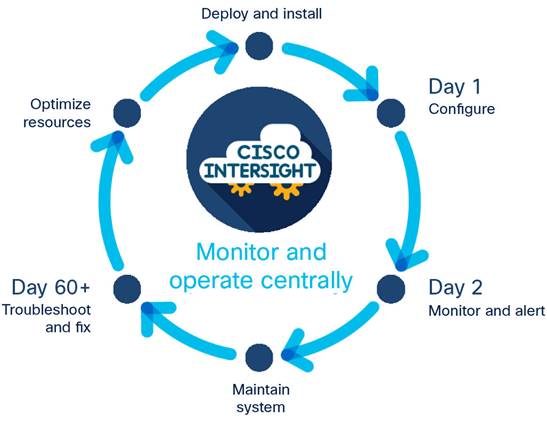
Cisco Intersight infrastructure lifecycle
Cisco Intersight Workload Optimizer
Cisco Intersight Workload Optimizer is an optional service that can be purchased with or without the Cisco Intersight platform license. It extends optimization capability in Cisco Intersight. It bridges the gap between applications and infrastructure to help ensure the performance of critical workloads while increasing efficiency and reducing costs across on-premises and hybrid cloud environments.
For IT teams challenged with balancing performance, efficiency, and cost in today’s complex, hybrid cloud environments, Cisco Intersight Workload Optimizer is a real-time decision engine that visualizes complex interdependencies across the stack. It simplifies and automates application resource management at scale by using telemetry data from over 50 targets across a range of hypervisors, computing platforms, container platforms, public clouds, and more with a single tool. It relieves IT teams from the day-to-day management of infrastructure and resource availability, giving them time to promote innovation for the business (Figure 2).
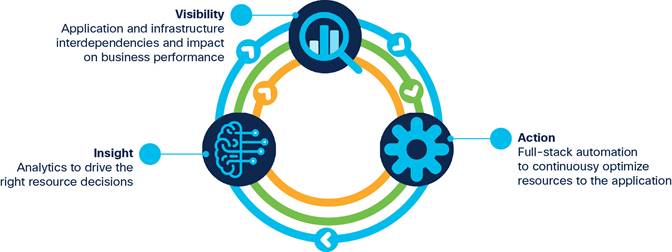
Cisco Intersight Workload Optimizer: Visibility > insight > action > visibility
Cisco Intersight Workload Optimizer makes it easy to see what is happening in your environment and understand how that affects your applications. You can:
● Gain visibility into the health, use, and performance of your infrastructure stack. Your operations and application teams can discover application and infrastructure interdependencies to make more informed decisions about how to apply and use IT resources.
● Get insight into infrastructure bottlenecks and factors that increase costs. Intelligent analytics stitch together each layer of the application and infrastructure stack, allowing resourcing decisions to be tied to application demand and relevant policies and constraints while factoring in available capacity.
● Trust actions that continuously optimize your infrastructure to deliver application performance. Specific real-time actions help ensure that your workloads get the resources they need when they need them, for placement, scaling, and capacity. You can automate the software’s decisions to match your level of comfort: recommend (view only), manual (select and apply), or automated (implemented in real time by software).
FlexPod is a defined set of hardware and software that serves as an integrated foundation for both virtualized and nonvirtualized solutions. FlexPod includes NetApp AFF storage, Cisco Nexus® networking, Cisco MDS storage networking, the Cisco Unified Computing System™ (Cisco UCS®), and VMware vSphere software in a single package (Figure 3). The design is flexible enough that the networking, computing, and storage resources can fit in one data center rack or be deployed according to a customer's data center design. Port density enables the networking components to accommodate multiple configurations of this kind.
One benefit of the FlexPod architecture is the ability to customize, or "flex," the environment to suit a customer's requirements. A FlexPod deployment can easily be scaled as computing, network, or storage requirements or demand changes. The unit can be scaled both up (adding resources to a FlexPod unit) and out (adding more FlexPod units). This wire-once fully validated architecture is highly resilient and cost effective and reduces customer risk.
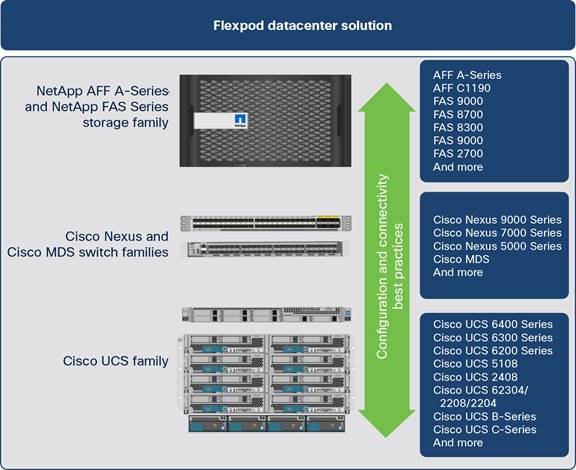
FlexPod component families
Setting up FlexPod Datacenter with Cisco Intersight Workload Optimizer
To use Cisco Intersight Workload Optimizer with FlexPod Datacenter, you need to prepare your system and set up Workload Optimizer.
Your system must meet certain prerequisites for you to use FlexPod Datacenter with Cisco Intersight Workload Optimizer. Follow these steps:
1. To establish communication between any on-premises target (vCenter or NetApp) in the data center and Cisco Intersight Workload Optimizer, you must do the following:
◦ Install a Cisco Intersight Assist appliance in the on-premises data center. The target service must be accessible to the Cisco Intersight Assist appliance.
◦ Connect the Cisco Intersight Assist instance with Cisco Intersight.
◦ Log in to Cisco Intersight and claim the Cisco Intersight Assist instance as a target.
2. Table 1 lists the resource requirement for Cisco Intersight Assist. Note that Cisco Intersight Assist with the Tiny deployment type is for the orchestration feature only. For Cisco Intersight Workload Optimizer, choose between the Small and Medium types based on workload.
Table 1. Cisco Intersight Assist resource requirements
| Resource |
System requirements |
|
|
|
Small |
Medium |
| Virtual CPU (vCPU) |
16 |
24 |
| RAM (GiB) |
32 |
64 |
| Storage (disk in GiB) |
500 |
500 |
| Deployment configuration |
Up to 1000 virtual machines |
Up to 30,000 virtual machines |
| Supported hypervisors |
VMware ESXi 6.5 and later |
|
3. To deploy up to 100,000 virtual machines, increase the vCPU to 32 and the RAM to 96 GB or more.
Note: For more information about requirements, see the Cisco Intersight Assist Getting Started Guide.
4. To discover and fully manage NetApp disk arrays, verify that Cisco Intersight Workload Optimizer has a service account that grants privileges to run commands through the NetApp storage controller’s ONTAP Rest API (ONTAPI).
5. Verify that Transport Layer Security (TLS) Version 1.2 is enabled on the NetApp storage controller.
6. Verify that Cisco Intersight Workload Optimizer is enabled.
7. Verify that you have a NetApp Storage Control Module license.
Enabling Cisco Intersight Workload Optimizer
You can enable Cisco Intersight Workload Optimizer either by using a trial license or by purchasing and registering a Cisco Intersight Workload Optimizer license tier.
To enable a trial license, following these steps:
8. Log in to Cisco Intersight with Account Administrator privileges.
9. From the Settings icon, choose Settings > License.
10. Click Start Trial.
11. Choose Workload Optimizer.
You can purchase any of the Cisco Intersight Workload Optimizer license tiers using the Cisco Ordering Tool. For more details, see Ordering Information in the Cisco Intersight data sheet.
To register a Cisco Intersight Workload Optimizer license in Cisco Intersight, do the following:
1. Log in to Cisco Intersight with Account Administrator privileges.
2. From the Settings icon, choose Settings > License and click Register.
3. On the Set Token page, enter the product instance registration token. Click Cisco Smart Software Manager to obtain your Cisco Intersight registration token. If you do not have a Smart Account, create one here. You can purchase the subscription and select the required Cisco UCS server volume tier for the selected subscription duration from the same Smart Account. Click Next.
4. On the Set Product page, toggle on Cisco Workload Optimizer and select the required license tier (Essentials, Advantage, or Premier). For more information about Cisco Intersight Workload Optimizer licensing tiers, see the Cisco Intersight Workload Optimizer Licensing section of the Cisco Intersight data sheet.
Getting started with the supply chain view
In Cisco Intersight Workload Optimizer, if you navigate to Optimize > Overview, you see the consolidated supply chain from Workload Optimizer (Figure 4). Market abstraction is fundamental to Workload Optimizer. It models all the elements of applications and infrastructure into a supply chain of buyers and sellers and relationships among the various elements. This supply chain represents the flow of resources from the data center, through the physical tiers of your environment, to the virtual tier, and out to the cloud. By managing relationships among these buyers and sellers, Cisco Intersight Workload Optimizer provides closed-loop management of resources, from the data center through to the application.
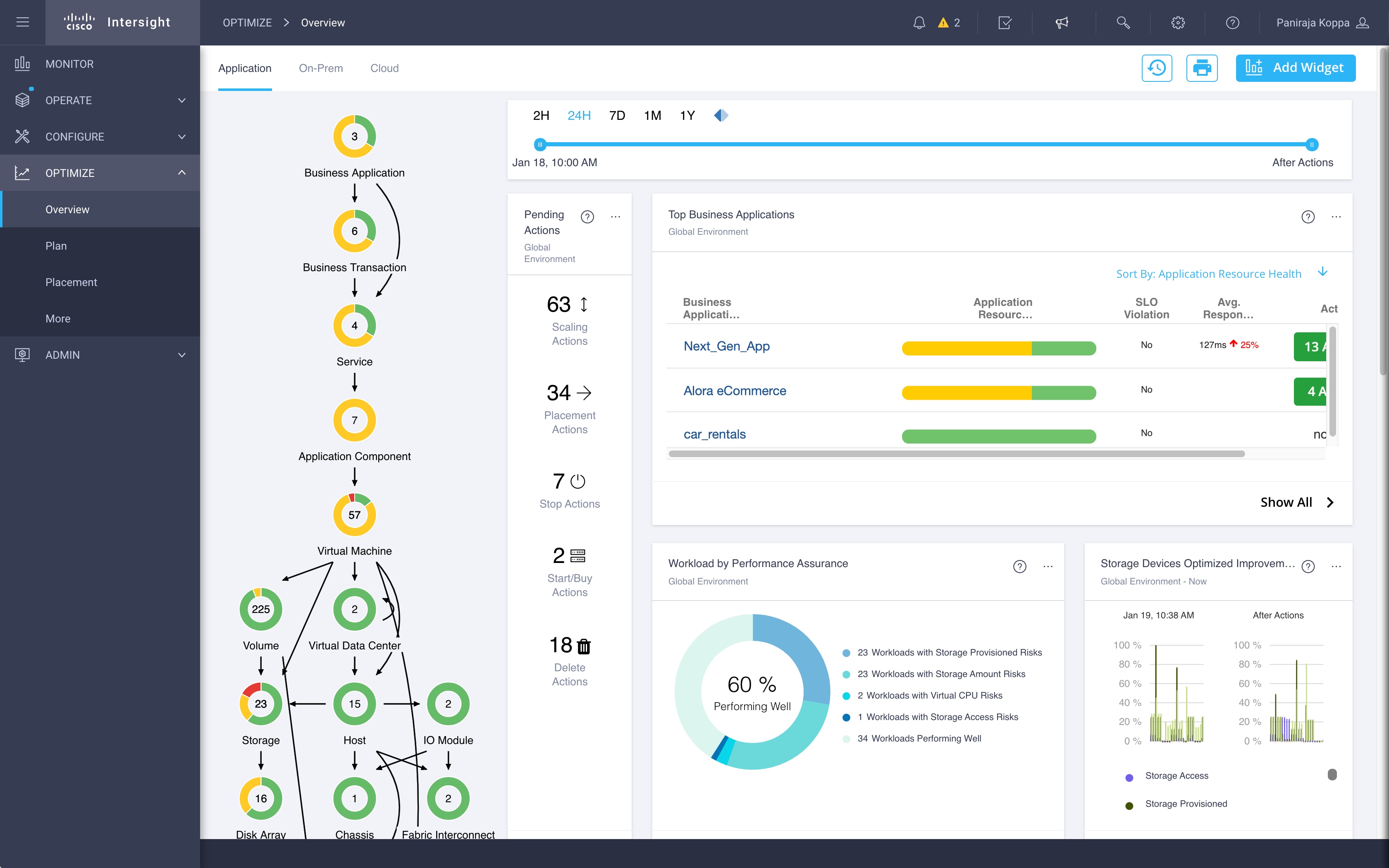
Overview page
Observe here that Cisco Intersight Workload Optimizer is making multiple recommendations to enable workloads to perform their best at the best possible cost while maintaining compliance. Workload Optimizer provides scale up and down, delete, start and buy, placement, configuration change, and stop actions that you can take on various elements (Figure 5).
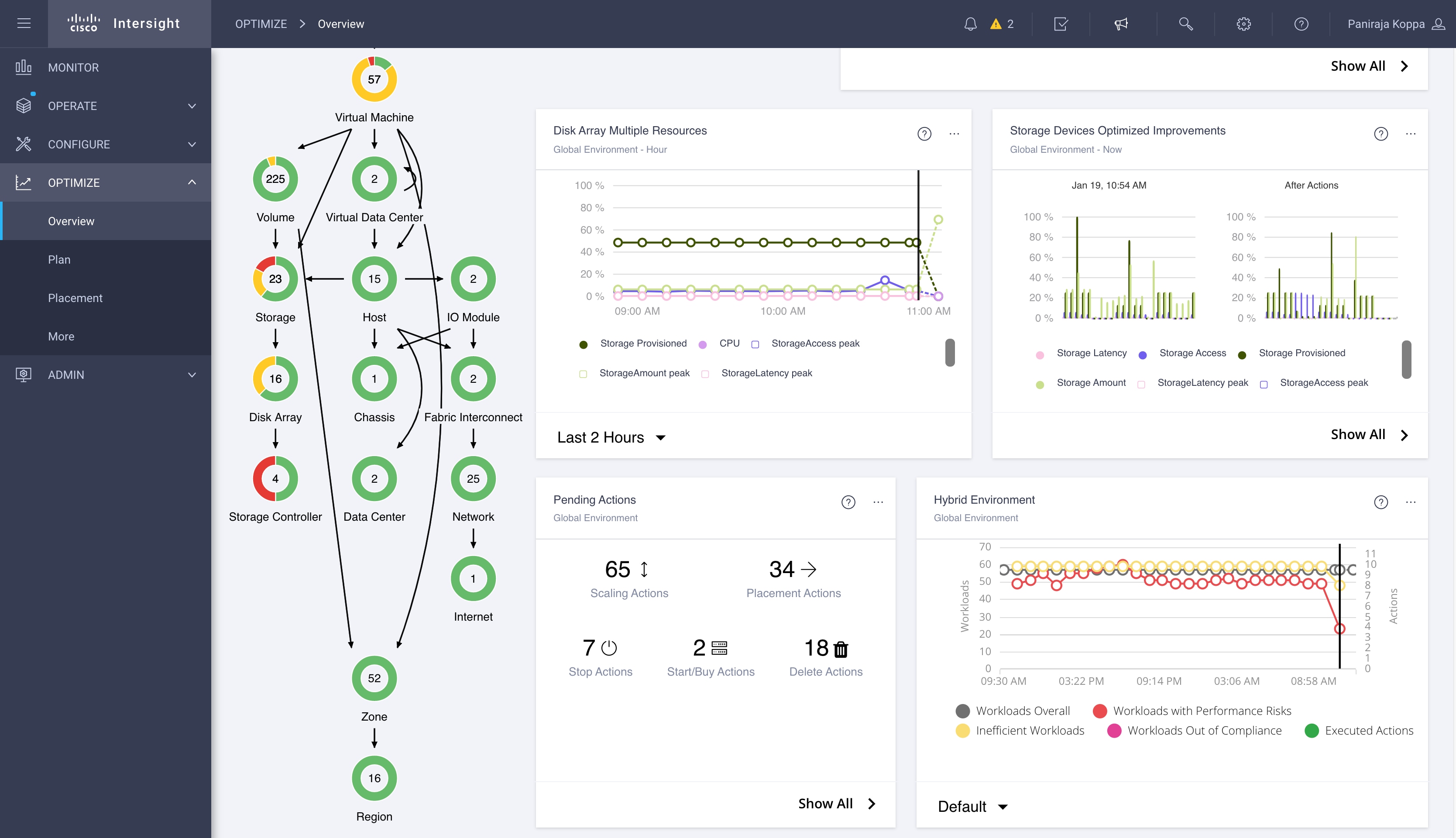
Overview page with storage-related widgets
The supply chain view enables you to understand your infrastructure. You then can look at issues associated with workloads.
This supply chain view is automatically created using the information gathered from the endpoints you have added. No manual input is required to create this relationship map. Cisco Intersight Workload Optimizer uses targets to monitor the workload and to implement actions. For each target, Workload Optimizer communicates with the service through the management protocol that it exposes: the representational state transfer (REST) API, Storage Management Initiative Specification (SMI-S), XML, or some other management transport. Workload Optimizer uses this communication to discover the managed entities, monitor resource use, and implement actions.
Cisco Intersight Workload Optimizer automatically manages compute, storage, and network resources across all major IT platforms and multicloud environments. It leverages telemetry data from a broad third-party ecosystem, supporting numerous targets across a range of hypervisors, compute platforms, container platforms, public clouds and more, to deliver intelligent recommendations based on a holistic view, for where to place and how to size and scale resources. Please refer to the Intersight Workload Optimizer Target Configuration Guide for additional information.
For FlexPod Datacenter, you can claim the targets listed in Table 2. A wide variety of other targets are supported as well.
Table 2. FlexPod-related targets and licensing information
| Category |
Target |
Minimum licensing tier required |
Cisco Intersight Assist required |
| Computing and fabric |
Cisco UCS server (standalone) Cisco UCS domain (managed by Cisco UCS Manager) |
Cisco Intersight Workload Optimizer Essentials |
No |
| Storage |
NetApp |
Cisco Intersight Workload Optimizer Essentials |
Yes |
| Hypervisor |
VMware vCenter |
Cisco Intersight Workload Optimizer Essentials |
Yes |
| Application performance management |
Cisco AppDynamics™ |
Cisco Intersight Workload Optimizer Advantage |
Yes |
| Cloud native |
Kubernetes |
Cisco Intersight Workload Optimizer Advantage |
No |
To add a target service, follow these steps:
1. Navigate to Admin > Targets > Claim a New Target.
2. Provide the requested information. Typical information you provide includes the following:
◦ Target type: Choose among the supported technologies.
◦ After you choose the technology, then choose the specific target type for that technology. For example, for Cloud Management, you can choose Amazon Web Services (AWS).
◦ Host name or IP address: Specify the address of the target service you want to add.
◦ Username: Specify a valid account username for the target service.
◦ Password: Specify a password for the target service account.
3. Click Apply to validate the targets and start a new discovery process.
If the installation of Cisco Intersight has already claimed a Cisco UCS device, then Cisco Intersight Workload Optimizer discovers the Cisco UCS environment automatically.
To claim a new Cisco UCS device, follow these steps:
1. Select the Compute/Fabric category and choose the type of device you want for a target.
2. Provide the following information:
◦ Device ID: Enter the applicable device ID. Endpoint devices connect to the Cisco Intersight portal through a device connector that is embedded in the management controller (the management virtual machine for Cisco UCS Director) of each system. The device connector provides a secure way for connected devices to send information and receive control instructions from the Cisco Intersight portal using a secure Internet connection.
◦ Claim code: The claim code authorizes your access. You can find this code in the device connector.
3. Click Claim. You can see the status of your claimed target on the Targets tab.
Claiming VMware vCenter targets
To claim a vCenter target, follow these steps:
1. Choose Hypervisors > VMware vCenter on the Target Configuration page (Figure 6).
2. Provide the following information:
◦ Host name or IP address: Enter the name or IP address of the vCenter server.
◦ Username and password: Enter the credentials for the user account that Cisco Intersight Workload Optimizer can use to connect to the vCenter server. Include the domain if required (<domain>\<username>).
◦ Enable the Datastore Browsing option: Enable this option so that Cisco Intersight Workload Optimizer can discover wasted storage.
3. Click Claim
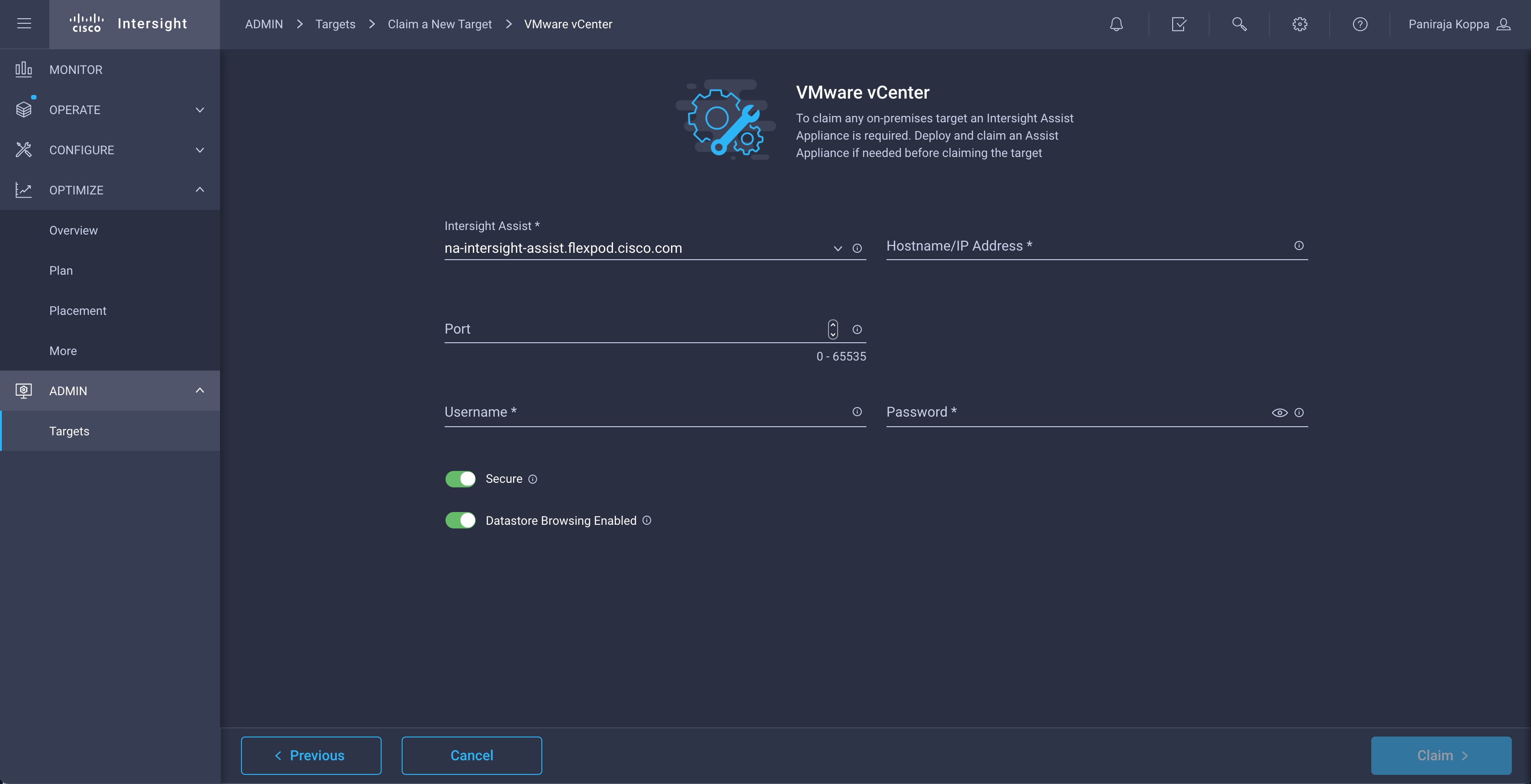
Claiming a VMware vCenter target
To claim a NetApp target, follow these steps:
1. Choose Admin > Targets > Claim New Target > Storage > NetApp Storage Controller on the Target Configuration page (Figure 7).
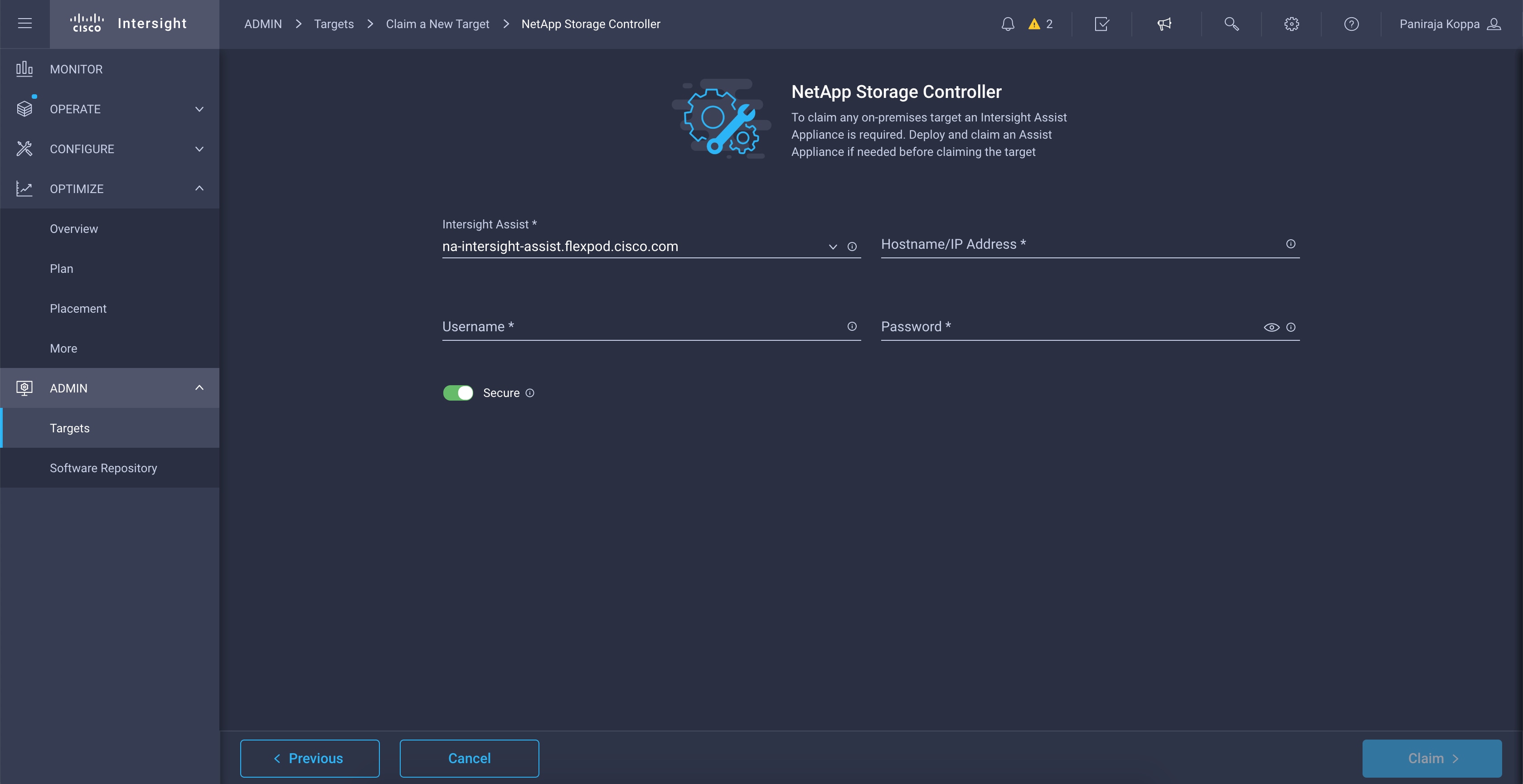
2. Provide the following information:
◦ The DNS hostname or IP address, either IPv4 or IPv6, to be used to connect to the managed NetApp Storage Controller target
◦ Username and password: Enter the credentials for the NetApp service user account that you have configured for Cisco Intersight Workload Optimizer to use.
3. Click Claim.
To perform intelligent workload balancing, Cisco Intersight Workload Optimizer collects raw data from various elements of FlexPod Datacenter: for example, VMWare VCenter, Cisco UCS blade and rack servers, and Kubernetes clusters. It polls these targets at 10-minute intervals to collect the latest data samples. It then uses these 10-minute data points to perform analysis and to display data in the GUI.
Adding a FlexPod target in addition to the hypervisor enriches the supply chain by giving the platform visibility into where storage resides. It also makes market analysis aware of the number of I/O operations per second (IOPS) and latency characteristics of the system for use by the eventual providers of the storage resources.
After validating a new target, Cisco Intersight Workload Optimizer discovers the connected storage entities. Table 3 compares terms used in NetApp with those used in Cisco Intersight Workload Optimizer.
Table 3. Storage entity mapping to NetApp names
| NetApp name |
Cisco Intersight Workload Optimizer entity |
| Volume |
Storage |
| Aggregate |
Disk array |
| Controller |
Storage controller |
Table 4 lists the Cisco UCS resources that Cisco Intersight Workload Optimizer monitors.
Table 4. Computing infrastructure monitored resources
| Entity type |
Resource |
| Physical machine |
Memory (Mem)
● The physical machine’s memory reserved or in use
● Measured in kilobytes (KB)
CPU
● The amount physical machine’s CPU reserved or in use
● Measured in megahertz (MHz)
I/O
● The utilization of the physical machine’s I/O adapters
● Measured in kilobytes per second (KBps)
Net
● The utilization of data through the physical machine’s network adapters
● Measured in KBps
Swap
● The utilization of the physical machine’s swap space
● Measured in KB
Balloon
● The utilization of shared memory among virtual machines running on the host
● VMware ESX only
● Measured in KB
CPU ready
● The utilization of the physical machine’s allocated ready queue capacity (measured in KB) that is in
● use, for 1, 2, and 4 CPU ready queues
● ESX only
● Measured in MHz
|
| Chassis |
Power
● Electricity being consumed by the chassis
● Measured in watts (W)
Temperature
● Internal temperature of the chassis
● Measured in degrees Celsius (°C)
|
| I/O module |
Net throughput
● Rate of message delivery over a port
● Measured in megabits per second (Mbps)
|
| Fabric interconnect |
Port channel
● Amalgamation of ports with a shared net throughput and utilization
● Measured in Mbps
|
Table 5 lists the resources that Cisco Intersight Workload Optimizer monitors for virtual machines.
Table 5. Virtual machine monitored resources
| Entity type |
Resource |
| Virtual machine |
Virtual memory (vMem)
● The utilization of the vMem allocated to the hosting virtual machine
● Measured in KB
Virtual CPU (vCPU)
● The utilization of the vCPU allocated to the hosting virtual machine
● Measured in MHz
Virtual storage (vStorage)
● The utilization of the virtual storage capacity allocated for the virtual machine
● Measured in KB
Storage access operations per second (IOPS)
● The utilization of IOPS allocated for the vStorage on the virtual machine
● Measured in IOPS
Latency
● The utilization of latency allocated for the vStorage on the virtual machine
● Measured in milliseconds (ms)
|
Table 6 lists the resources that Cisco Intersight Workload Optimizer monitors for NetApp storage.
Table 6. Storage monitored resources
| Entity type |
Resource |
| Volume |
Storage amount
● The utilization of the data store's capacity
● Measured in megabytes (MB)
Storage provisioned
● The utilization of the data store's capacity, including overprovisioning
● Measured in MB
Storage access operations per second (IOPS)
● The summation of the read and write access operations per second on the data store.
● Measured in IOPS
Latency
● The utilization of latency on the data store
● Measured in ms
|
| Aggregate (disk partitions in one or more RAID groups) |
Disk array storage amount
● The utilization of the disk array's capacity
● Measured in MB
Storage provisioned
● The utilization of the disk array's capacity, including overprovisioning
● Measured in MB
Storage access operations per second (IOPS)
● The summation of the read and write access operations per second on the disk array
● Measured in IOPS
Latency
● The utilization of latency computed from the latency of each device in the disk array
● Measured in ms
|
| Controller |
CPU
● The utilization of the storage controller's CPU in use
● Measured in MHz
Storage amount
● The utilization of the storage controller's capacity
● The storage allocated to a storage controller is the total of all the physical space available to aggregates managed by that storage controller
● Measured in MB
|
Cisco Intersight Workload Optimizer makes multiple recommendations to enable workloads to perform their best, at the best possible cost while maintaining compliance. It has recommendations for scale up and down, move, delete, start and buy, placement, configuration change, and stop actions that you can take on various elements.
Table 7 summarizes the actions for the various entities of FlexPod Datacenter. Recommendations are supported for NetApp Storage Systems running Data ONTAP version 8 or later.
Table 7. Summary of actions
| Entity type |
Action |
| Virtual machine |
● Provision additional resources (vMem and vCPU)
● Move virtual machine
● Move virtual machine storage
● Reconfigure storage
● Reconfigure virtual machine
|
| Physical machine |
● Start physical machine
● Provision physical machine
● Suspend physical machine
|
| Chassis |
● Provision new chassis
|
| Fabric interconnect |
● Add port to port channel
● Remove port from port channel
● Add port
|
| Storage controller |
● Recommendations for storage controller provisioning
|
| Disk array |
Recommendations for:
● Resize up
● Move (C-Mode only)
● Provision (C-Mode only)
|
| Storage |
Recommendations for:
● Delete (volume)
● Suspend
● Delete (data store)
● Move
● Provision
● Start
● Resize (up, down, above maximum, or below minimum, using tuned scaling)
|
If you plan to automate certain actions, be aware that Cisco Intersight Workload Optimizer does not automate the same actions in the same way for all technologies. This is because the underlying technologies do not provide the same degree of automation. For example, assume that you set the storage move actions to be automated for all virtual machines. In that case, Workload Optimizer can automate storage moves for virtual machines managed by vCenter and Red Hat Enterprise Virtualization (RHEV), but it cannot automatically implement storage moves for virtual machines managed by Microsoft Hyper-V or Citrix XenServer. This is because Hyper-V and XenServer do not provide programmatic access to the storage move operation. In this case, Workload Optimizer will continue to recommend that you perform the storage move using the Hyper-V or XenServer console.
Refer to the Cisco Intersight Workload Optimizer User Guide for more details.
Cisco Intersight Workload Optimizer user interface
Select the On-Prem tab to see details about the on-premises environment (Figure 8). You can see how applications correlate with virtual machines, clusters, Cisco UCS hosts and chassis, fabric interconnects, storage, etc. You can also see various widgets specific to the on-premises data center.
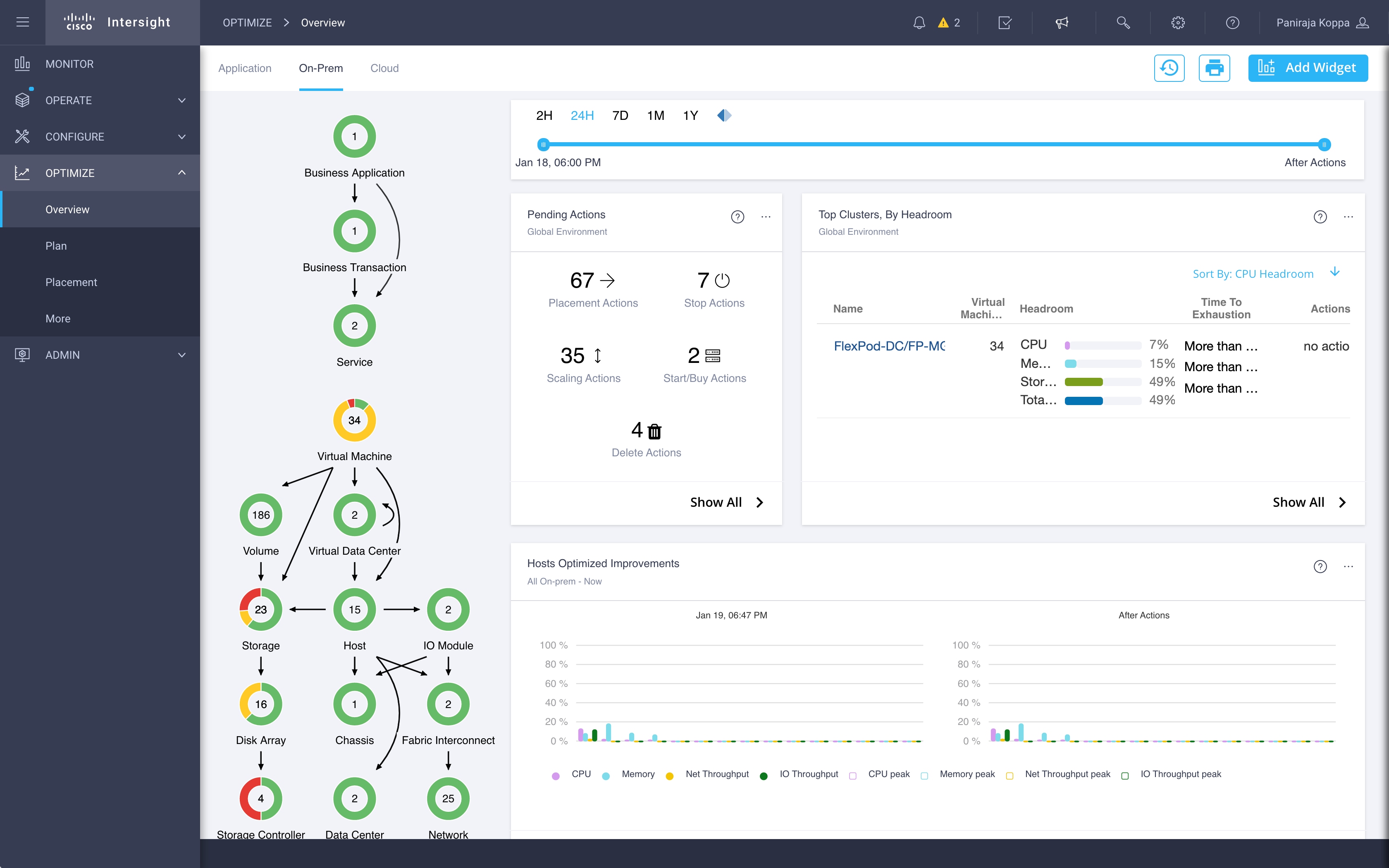
On-premises view
The supply chain shows all the on-premises entities in your environment. The charts show details about your environment, including the following:
● Overviews of pending actions: Cisco Intersight Workload Optimizer makes multiple recommendations (such as scale up and down, delete, start and buy, placement, configuration change, and stop actions) to enable workloads to perform their best with the best use of resources. A list will be displayed.
● Top cluster utilization: See a list of the most-used clusters. The chart shows these clusters, along with a count of actions for each. To drill down into the cluster details, click the cluster name. To see and implement the specific actions, click the Actions button for that cluster. To see all the clusters in your environment, click Show All.
● Optimized improvements: Compare current resource utilization with the utilization you would see if you choose to implement all the pending actions.
● Action history: See a history of all the actions that have been recommended and implemented, or of just the actions that have been accepted and implemented.
By looking at the supply chain, you can see the following:
● The number of entities on each tier: Each entry in the supply chain has a count of the entities for the given type.
● The overall health of entities in each tier: The ring for each entry indicates the percentage of pending actions for that tier in the data center. Ring colors indicate how critical the actions are.
◦ Green shows the percentage of entities that have no actions pending.
◦ Red show the percentage of entities that have performance-related recommendations.
◦ Yellow indicates efficiency and compliance recommendations.
● The flow of resources between tiers: The arrow from one entry to another indicates the flow of resources. For example, the Virtual Machine entry has arrows to hosts and to storage. If the virtual machines are running in a virtual data center, the entry will have an arrow to that as well. This means that your virtual machines consume resources from hosts, from storage, and possibly from virtual data centers.
To get actual counts of pending actions, hover on a ring to see more details. Figure 9 shows that the system has 23 storage devices, of which 17 percent have performance-related recommendations.
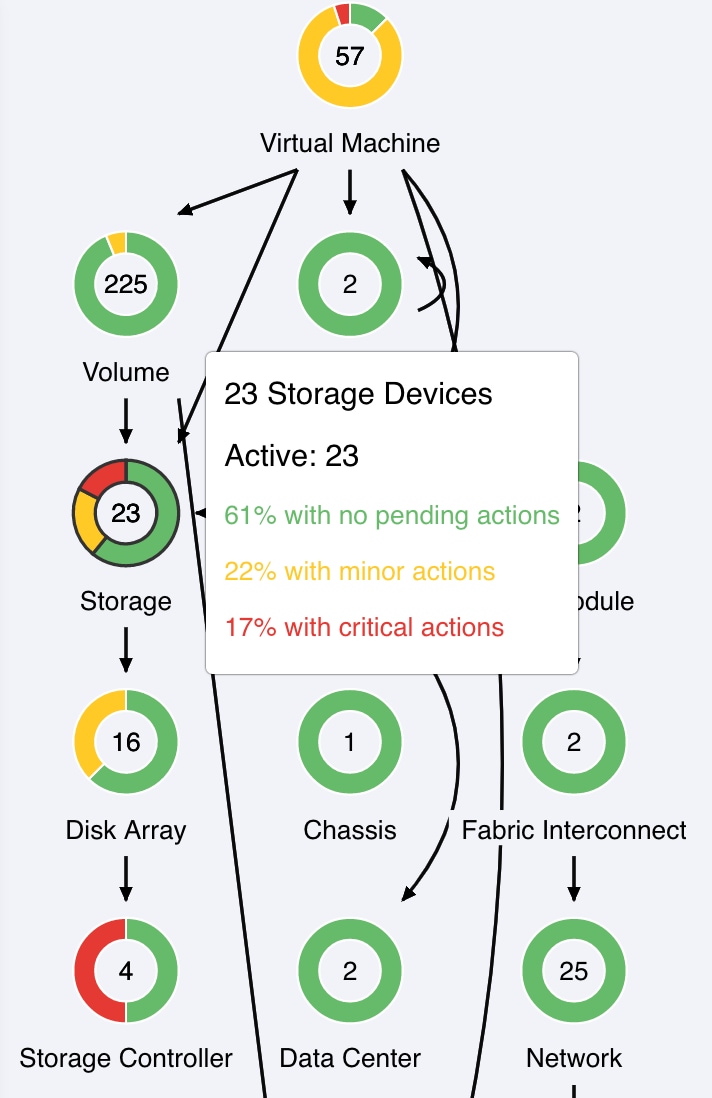
Supply chain focused on storage entities
You can click on an entity tier in the supply chain to see a list of those entities with specific details pertaining to that entity. For example, click Storage to see the details of the storage devices in your environment: pending actions, health, top storage devices, capacity, use, etc. (Figure 10).
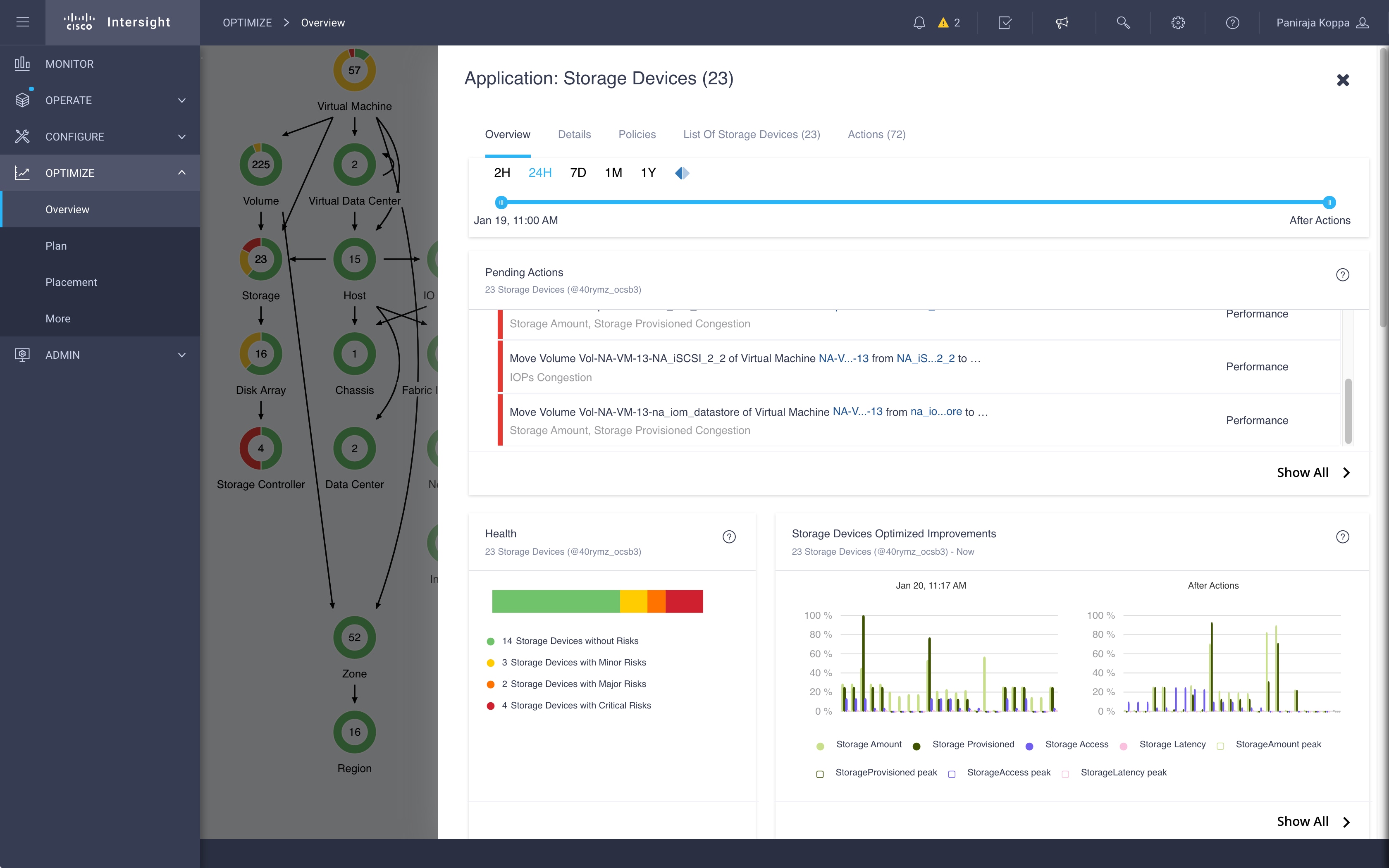
Details of a particular storage device
You can navigate between various tabs to view an overview, details (such as storage amount and storage provisioned), policies, and a list of storage devices and all the actions that you can perform on them (Figure 11 and Figure 12).
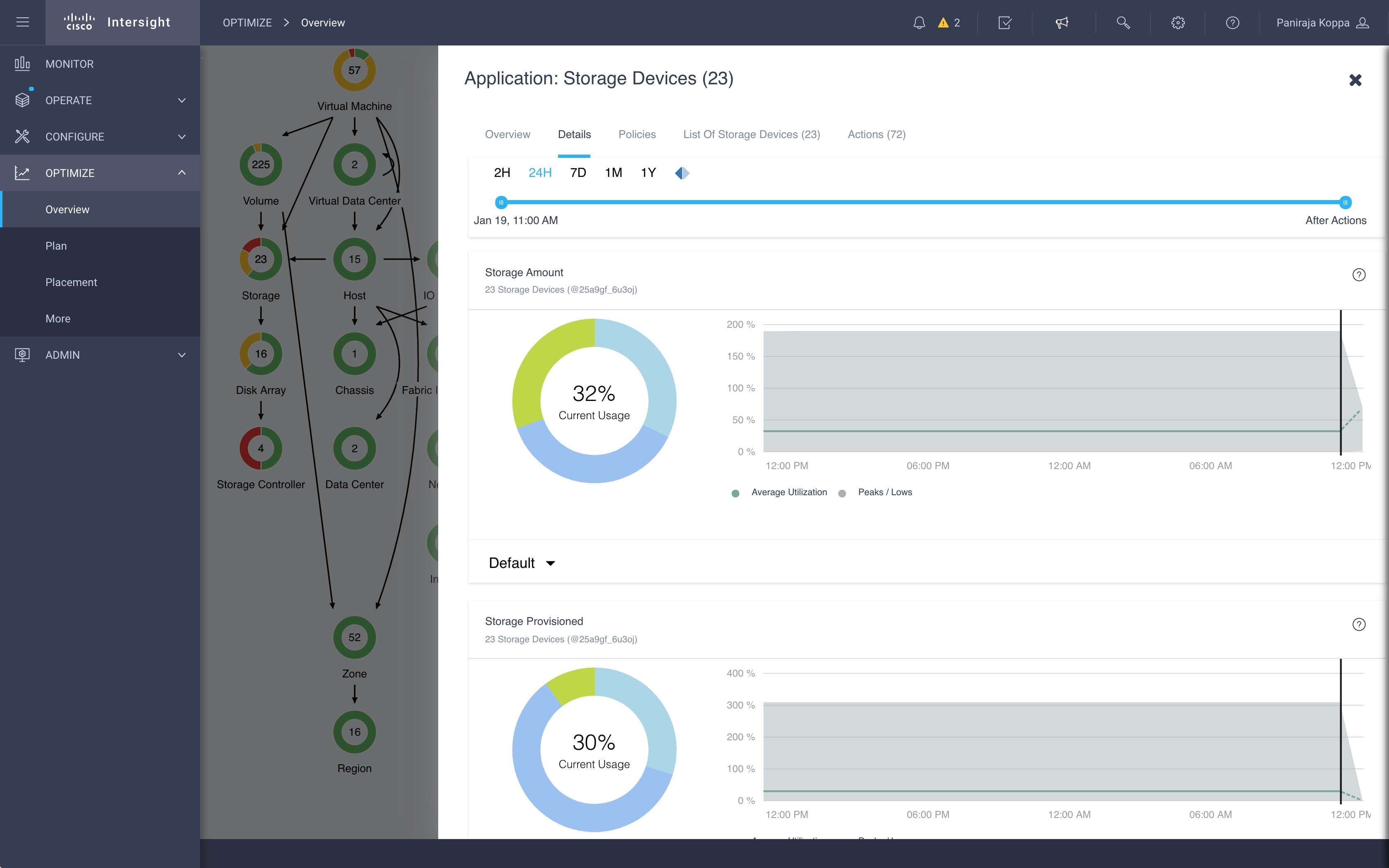
Details of a storage device
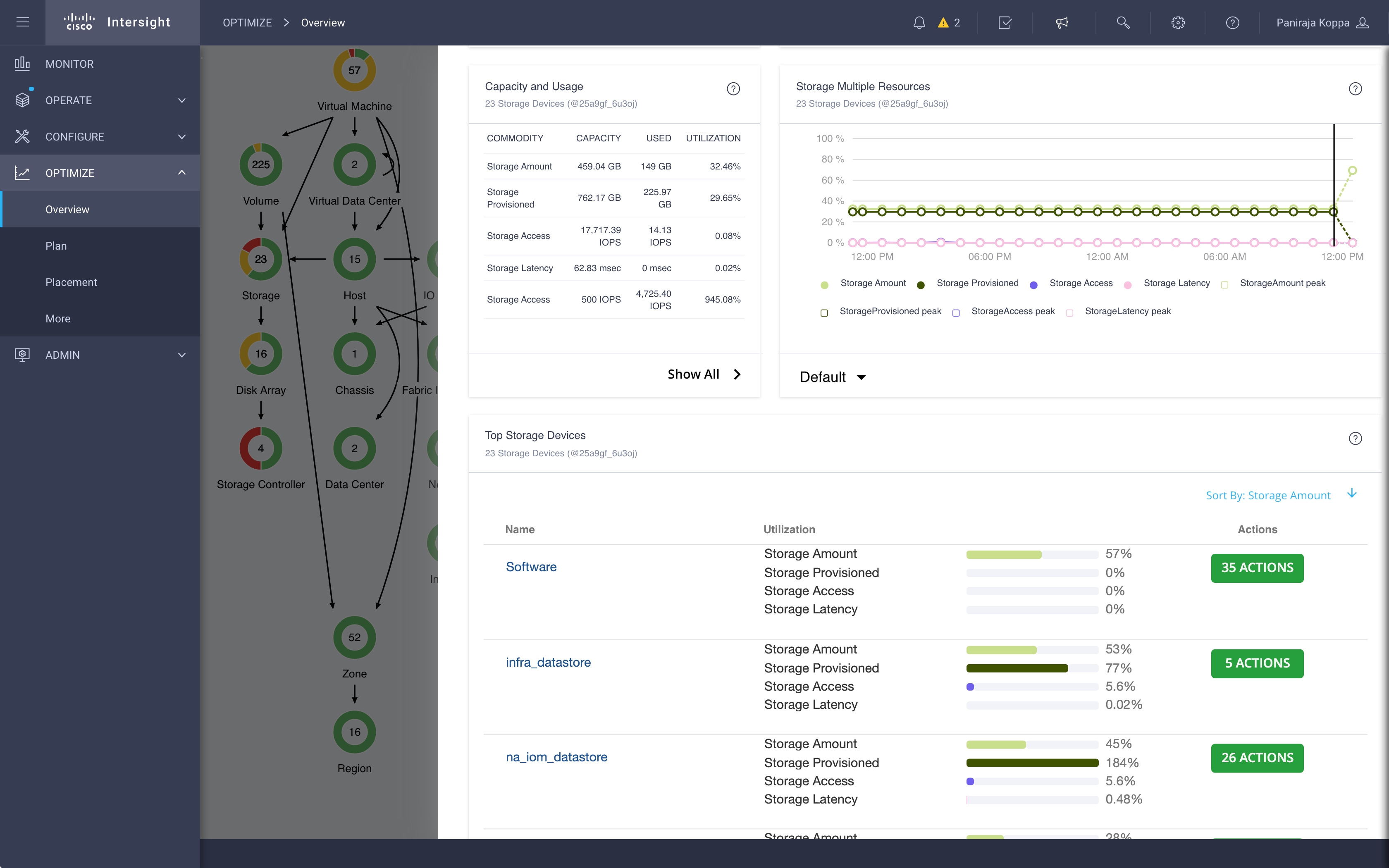
Details showing storage widgets
Similar operations are available for other FlexPod entities: virtual machines, volumes, aggregates, storage controllers, and other computing elements.
You can scope to one particular entity and view the entire supply chain and other details for only that entity. This scoped view enables you to zoom in on an entity in the environment and get a quick picture of system health, actions, relationships with other entities, and all other details for that scope.
The example in Figure 13 shows scoping to a storage entity, by choosing Storage > List of Storage Devices and clicking on one of the storage devices in the list.
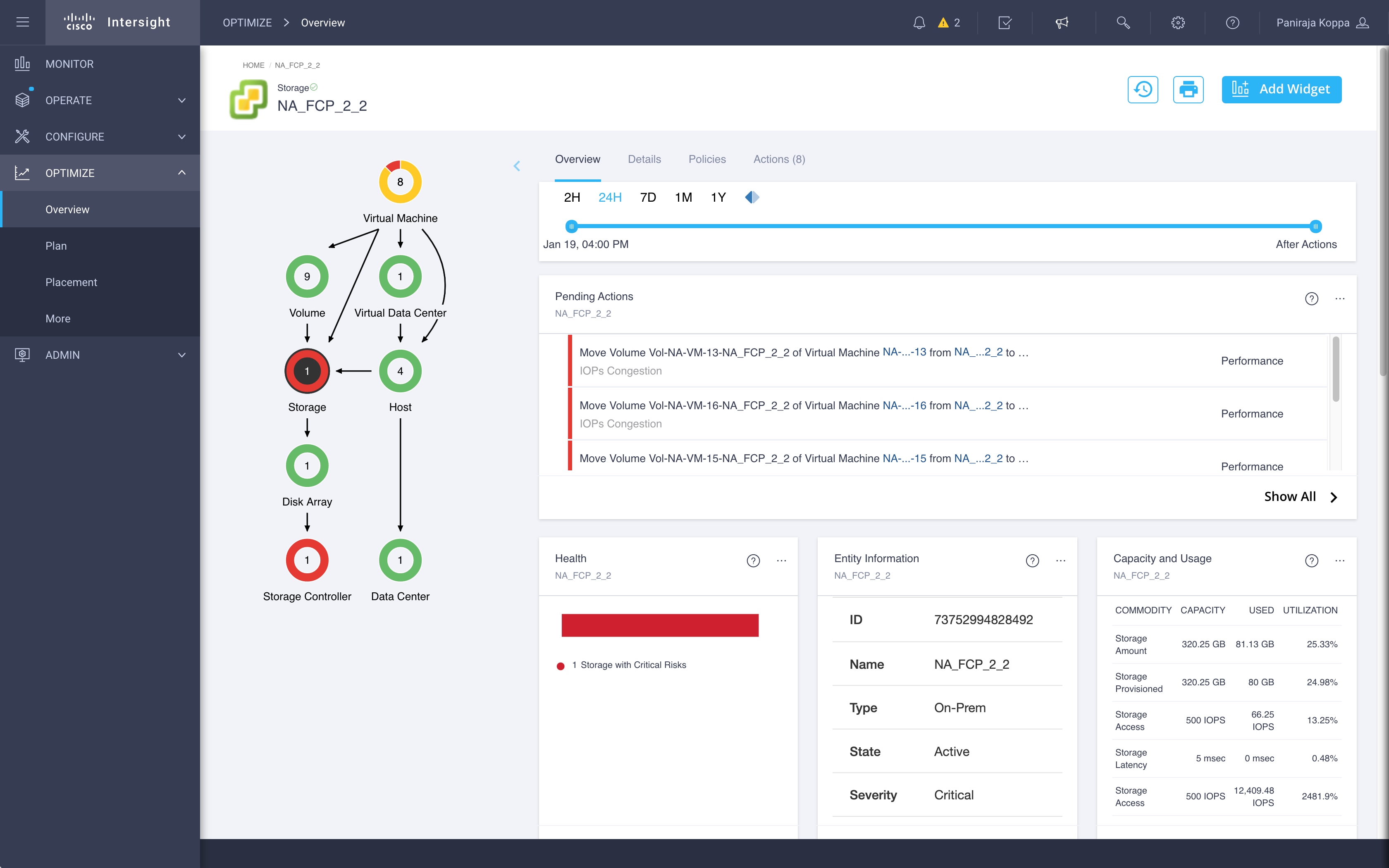
Scoping to a storage device
In this supply chain scoped to a storage device (a NetApp volume), you can see the aggregate to which this volume belongs, the controller that owns it, the virtual machines that are making use of the data store from this volume, etc.
The pending actions, health, capacity, and use, etc. are specific this particular storage volume.
Cisco Intersight Workload Optimizer makes multiple recommendations to enable workloads to perform their best at the best possible cost while maintaining compliance. This section presents some examples of recommendations for virtual machines, hosts, and storage.
Recommendations for virtual machines
Cisco Intersight Workload Optimizer discovers virtual machines through your added VMware targets. If utilization is high enough, Workload Optimizer can allocate more resources to the virtual machine, provision another instance, or move the virtual machine to a host that has more resources. If utilization decreases, Workload Optimizer can post recommendations to reduce the resources.
Some examples of recommendations that Cisco Intersight Workload Optimizer provides for virtual machines are discussed in the following sections.
Recommendations for virtual machine policy compliance
When calculating workload placement, Cisco Intersight Workload Optimizer respects cluster boundaries, networks, and provisioned data stores. These boundaries impose segments on the market view that Workload Optimizer uses to model virtual infrastructure. The example in Figure 14 shows a recommendation for a virtual machine that does not comply with a policy (a group of virtual machines must run on a storage device).
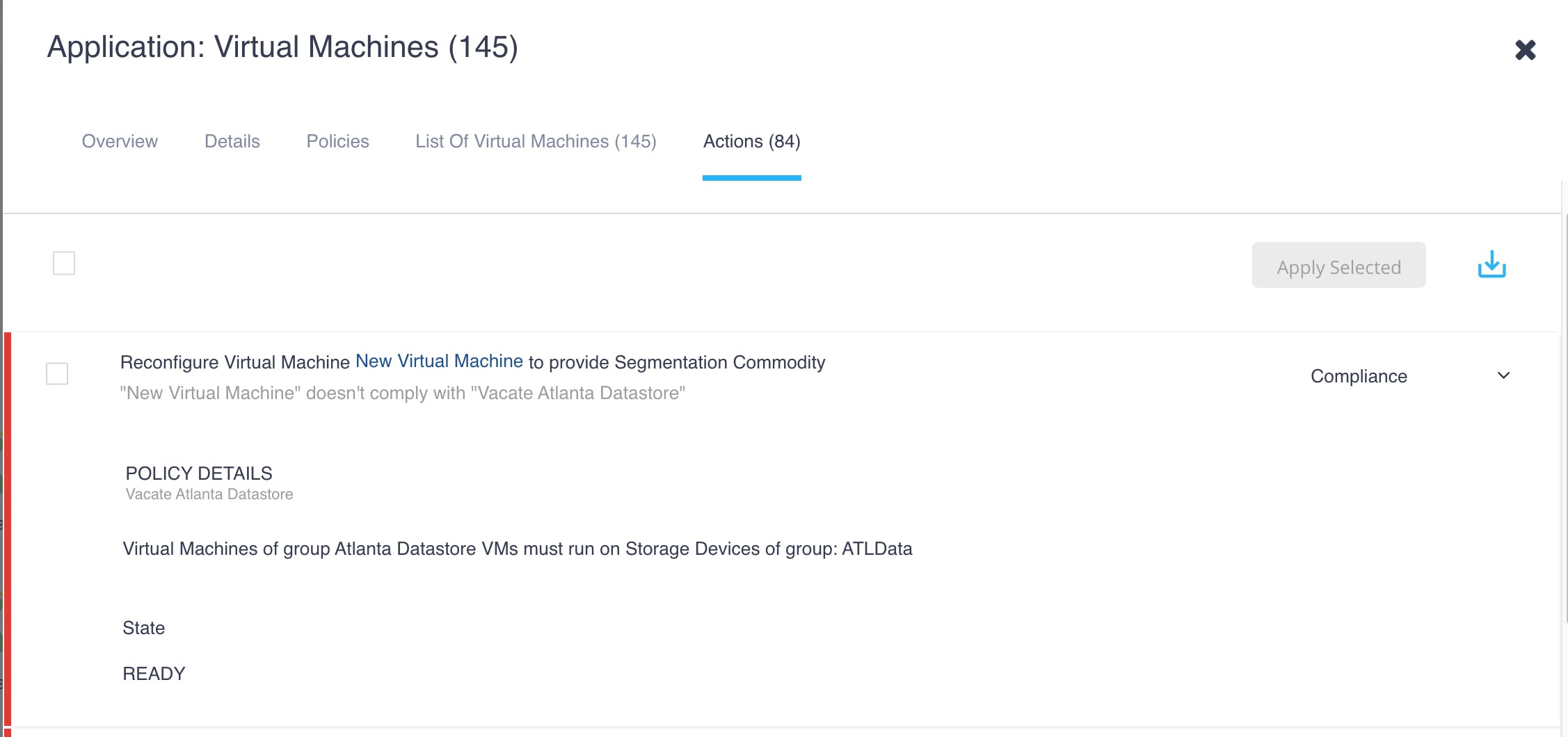
Recommending a compliance action for a virtual machine
Recommendations to improve overall performance of virtual machines
Cisco Intersight Workload Optimizer monitors the utilization of the resource allocated to the hosting virtual machine (for example, vCPU and vMem) and recommends provisioning additional or fewer resources.
In the example in Figure 15, CPU utilization is high in a virtual machine, so Workload Optimizer recommends increasing the size of the vCPU.
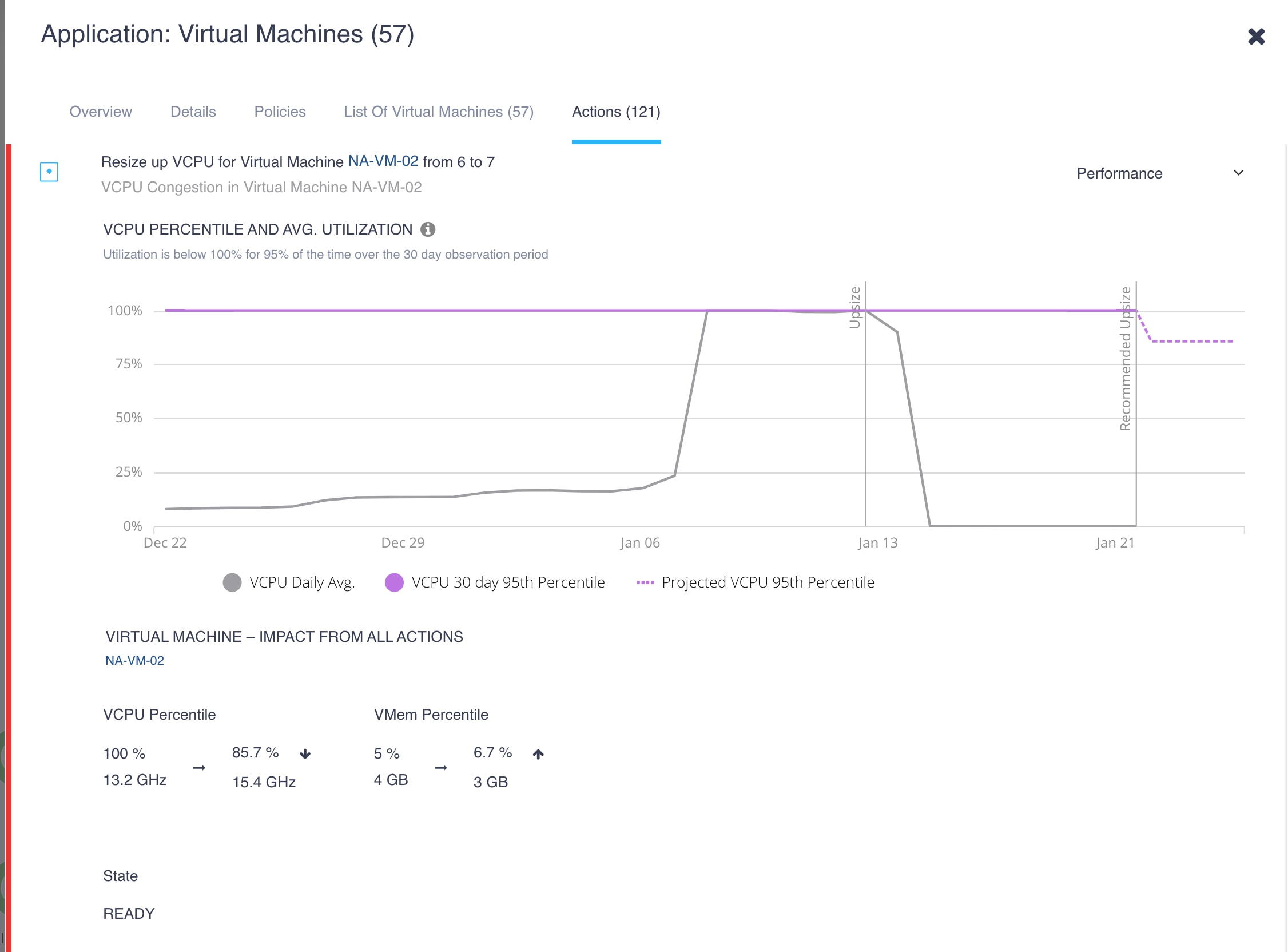
Recommendation to increase the size of the vCPU for better virtual machine performance
Recommendations to improve infrastructure utilization
The example in Figure 16 shows an underutilized vCPU in a virtual machine. Cisco Intersight Workload Optimizer recommends decreasing the size of the vCPU so the utilization percentage increases.
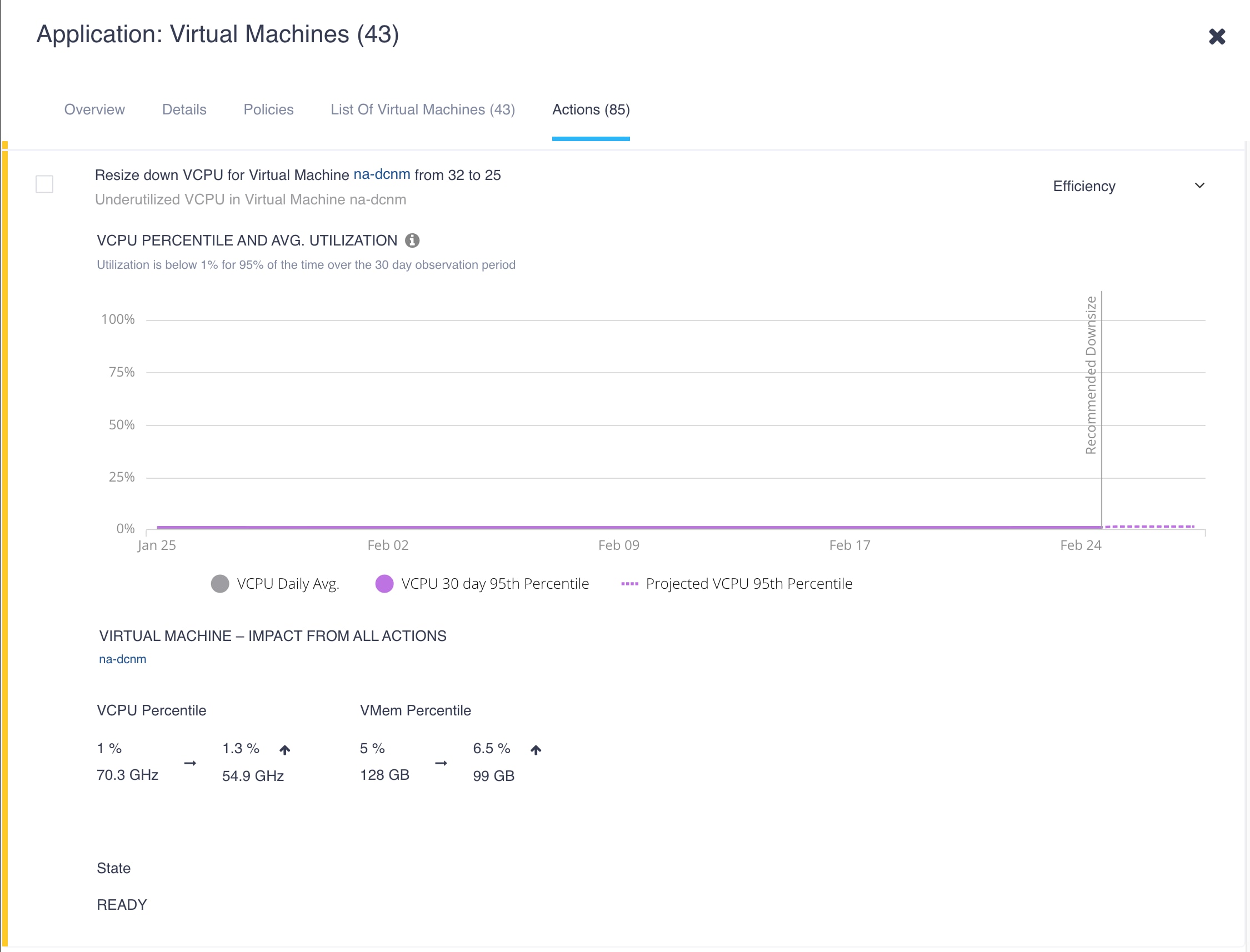
Recommendation to decrease the size of the vCPU
Cisco Intersight Workload Optimizer monitors the utilization of the vMem allocated to the hosting virtual machine and recommends provisioning additional memory or reducing the amount.
In the example in Figure 17, Workload Optimizer recommends resizing vMem so the utilization percentage increases.
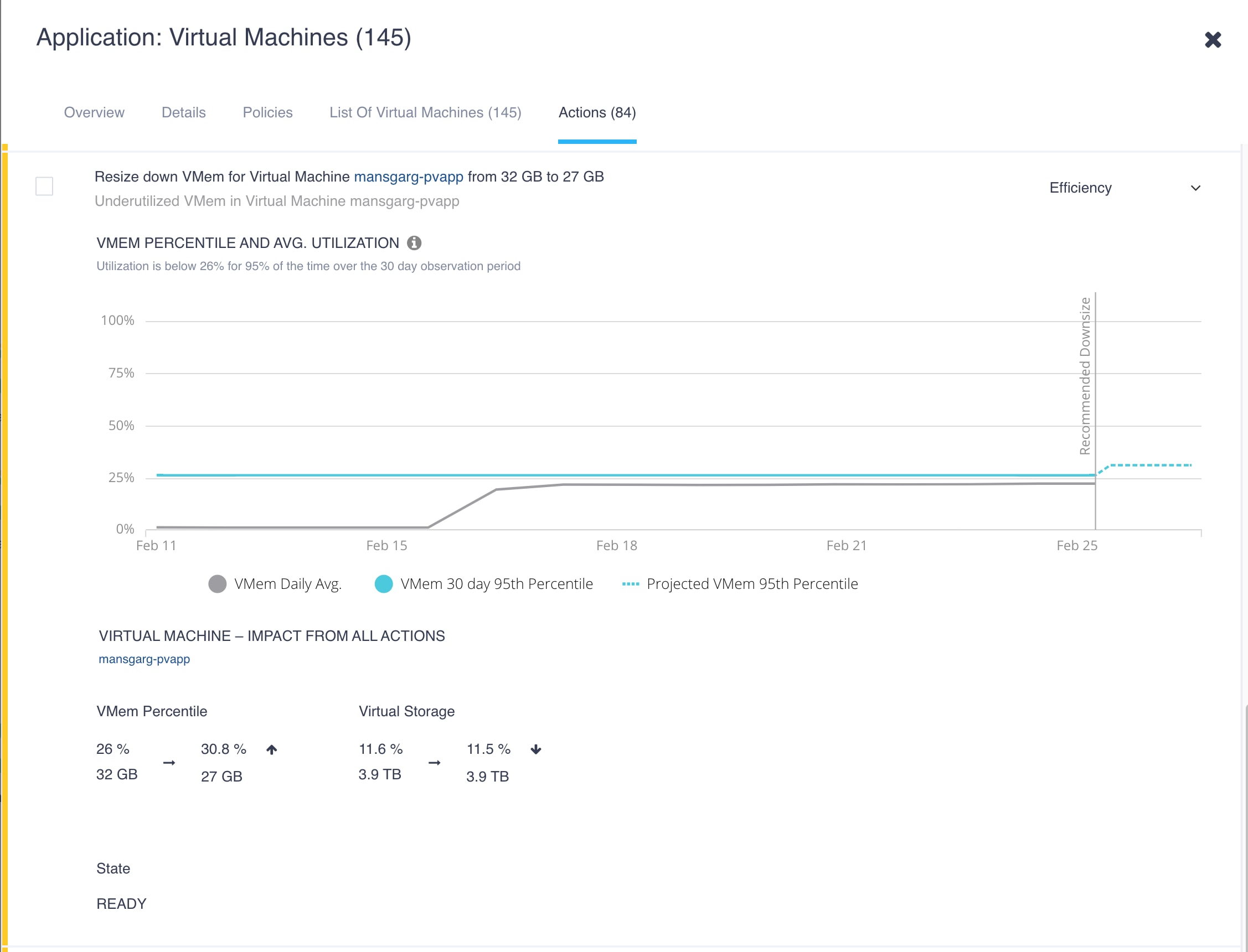
vMem recommendation to improve efficiency.
Recommendations to move virtual machines from a host for better performance
Cisco Intersight Workload Optimizer recommends moving virtual machines from one host to other so that overall performance of virtual machines is increased.
The example in Figure 18 shows memory congestion in the source host. By moving a virtual machine, this congestion can be avoided.
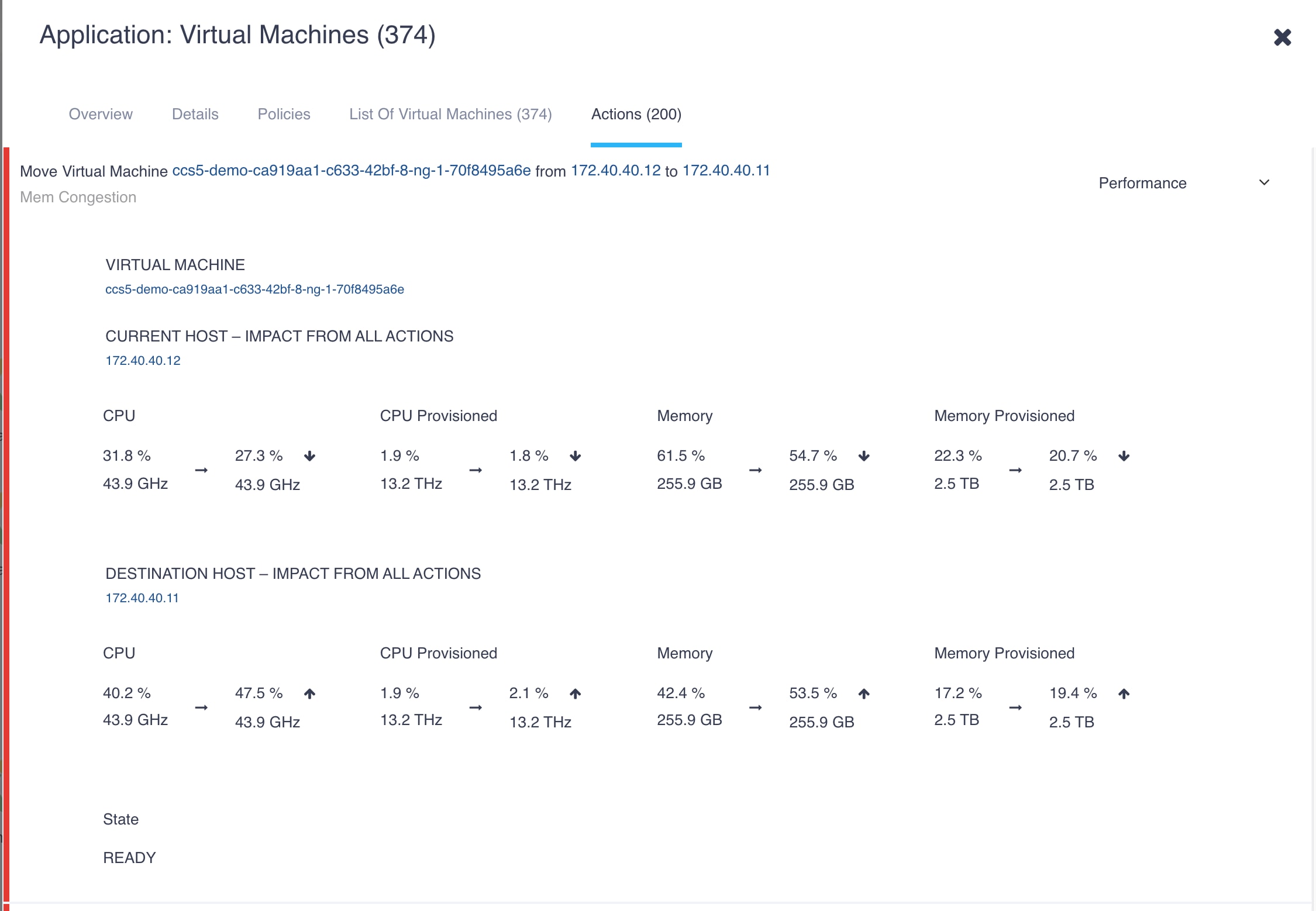
Recommendation to move a virtual machine for better performance
Recommendations to move virtual machines from a host for efficiency
Cisco Intersight Workload Optimizer recommends moving virtual machines from a host so that the host can be suspended without any impact on the performance of the virtual machines.
In the example in Figure 19, Workload Optimizer recommends moving virtual machines from one host to other hosts to increase the efficiency of the infrastructure. Figure 20 shows the impact of such a move.
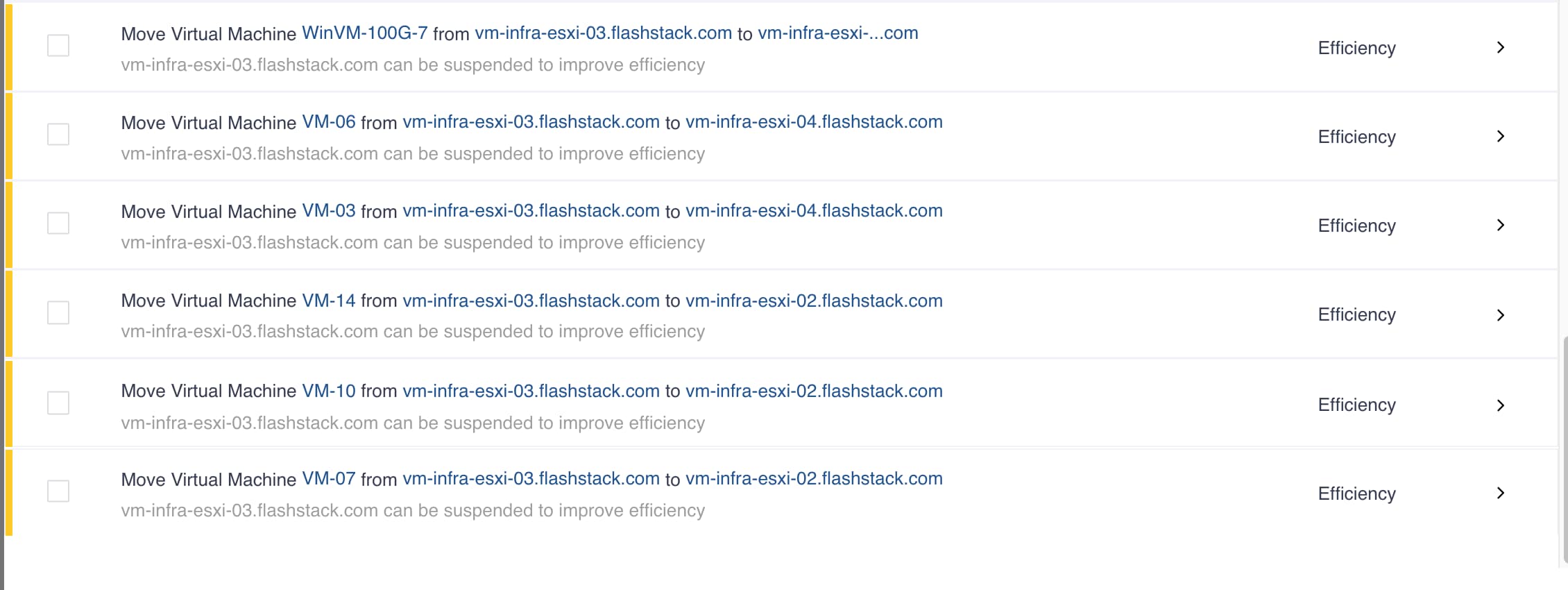
Recommendation to move virtual machines from one host to multiple other hosts for better efficiency
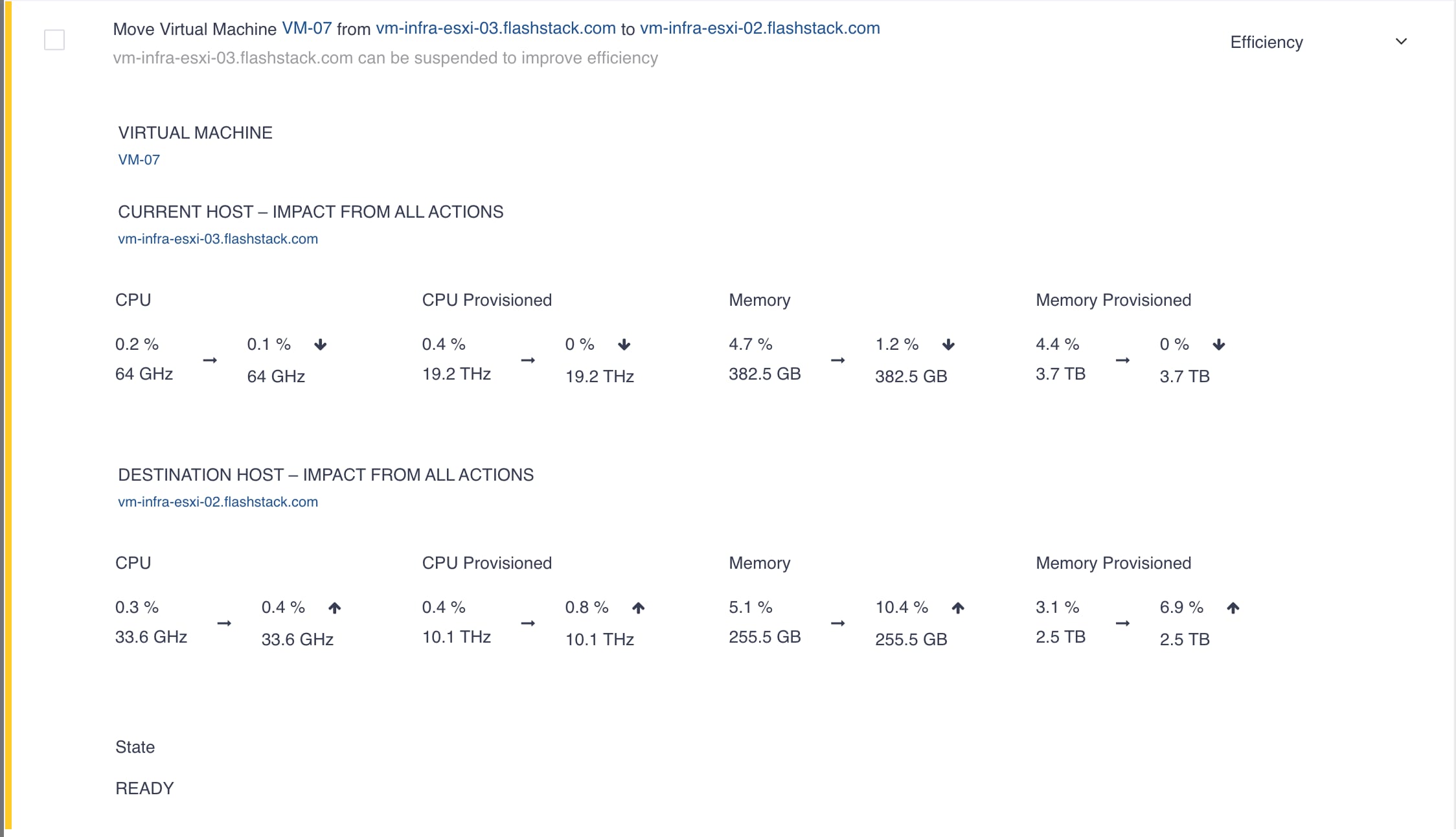
Impact of moving virtual machines
Cisco Intersight Workload Optimizer discovers on-premises data stores through VMware targets and storage controllers. A disk array provides storage volumes to serve the storage requirements of physical machines. It uses the resources of one storage controller, which is a device that manages one or more disk arrays. The storage controller provides CPU cycles to perform storage management tasks for each disk array it manages.
In the example in Figure 21, Workload Optimizer recommends moving the virtual machine's volume from one storage resource to another to avoid IOPS congestion and a storage utilization bottleneck.
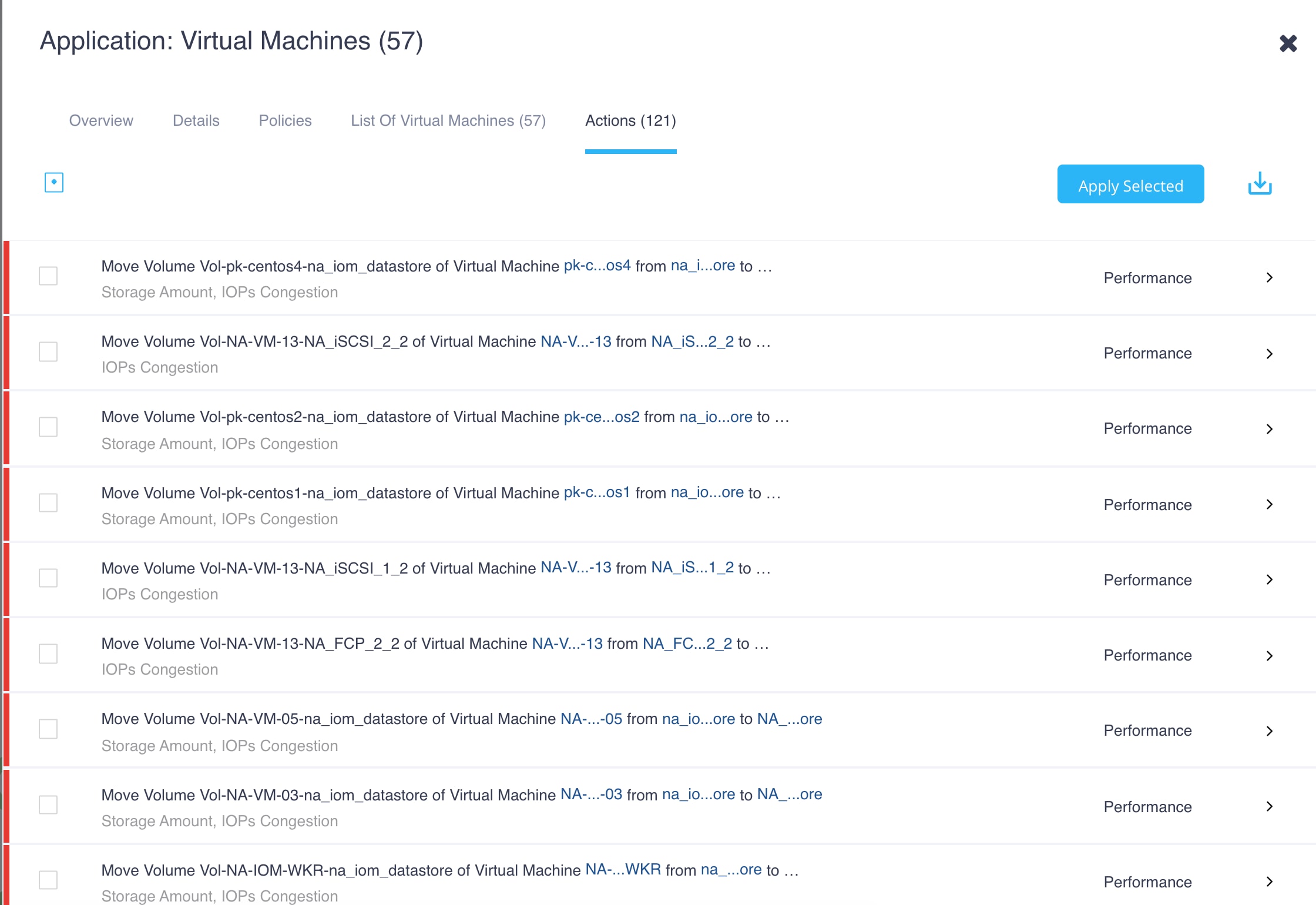
Recommendation to avoid IOPS congestion
Figure 22 shows recommendations to move the virtual machine's volume to a different storage resource so that a NetApp volume can be suspended.

Recommendation to move a virtual machine's volume to a different storage so that a NetApp volume can be suspended
Recommendations to delete unused files
Cisco Intersight Workload Optimizer monitors the idle and unused files in the data store and recommends that such files be deleted (Figure 23). These files could be Virtual Machine Disk (VMDK) files for a deleted virtual machine, dumps, and other temporary files.
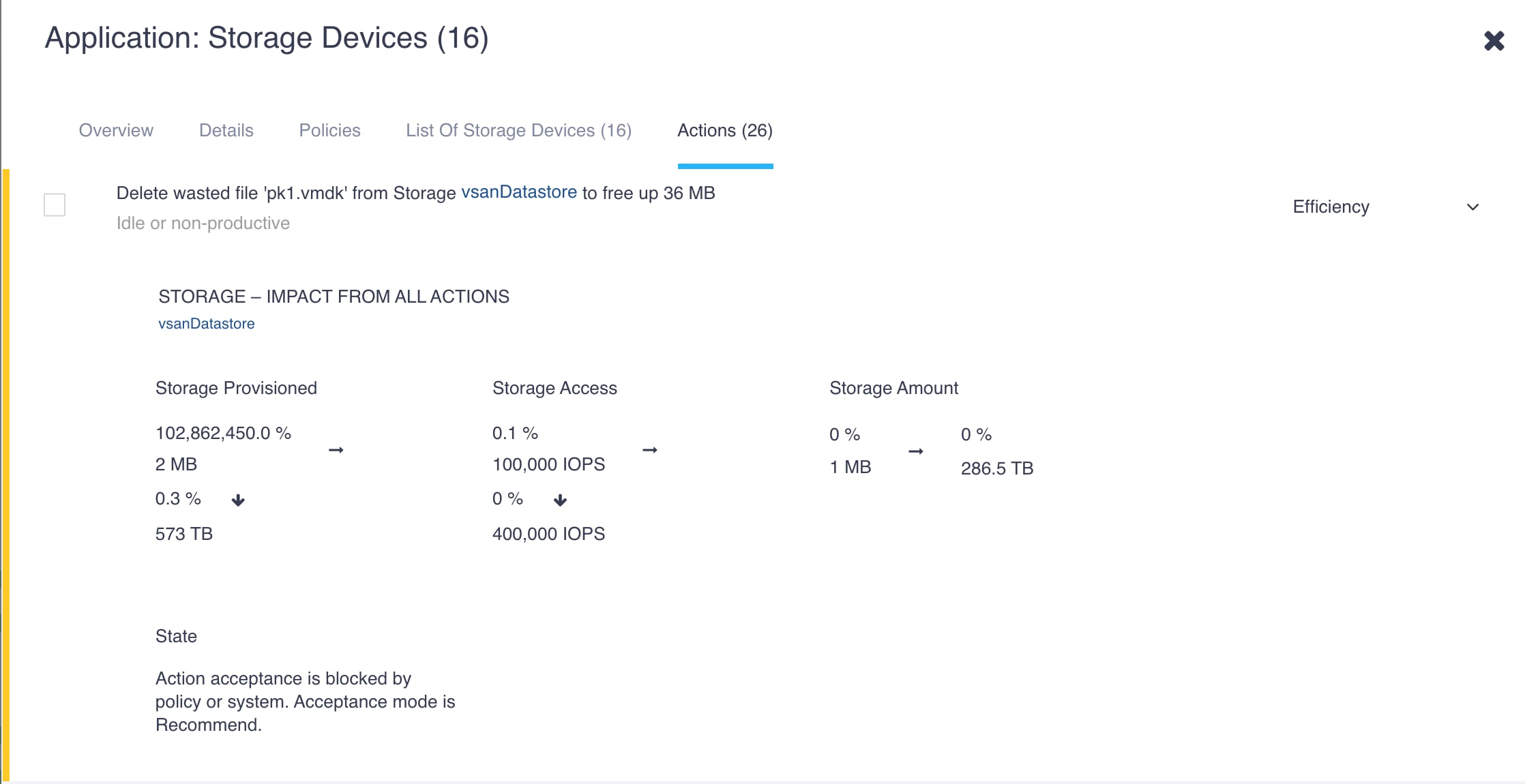
Recommendation to delete unused files
Recommendations to avoid IOPS congestion in virtual machine disks
Cisco Intersight Workload Optimizer monitors storage access operations per second. For high utilization of a virtual machine disk, it recommends moving from one data store to another.
In the example in Figure 24, Workload Optimizer recommends moving a VMware virtual machine’s volume from one NetApp volume to another because of IOPS congestion.
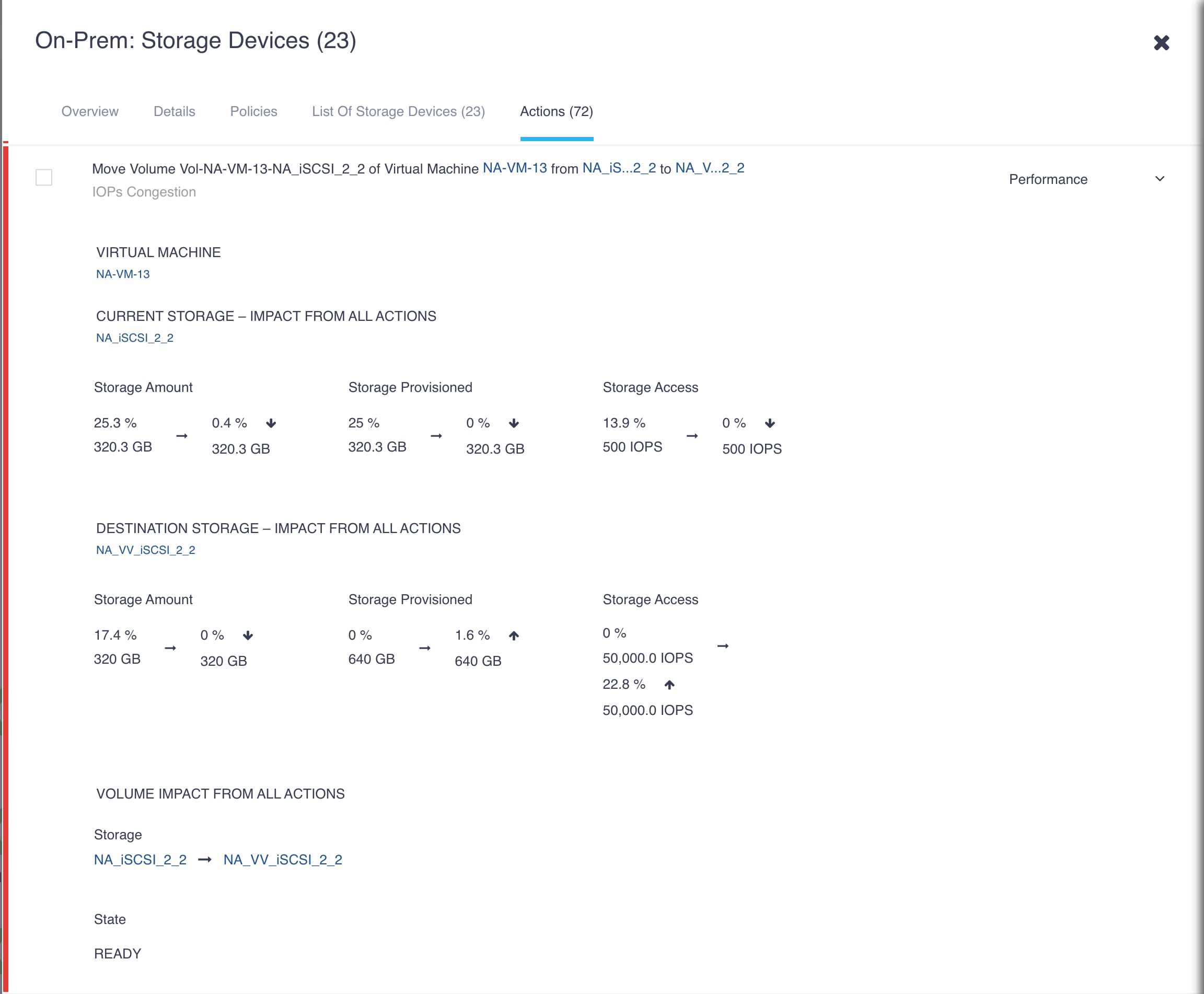
Recommendation to move a VMware virtual machine’s volume from one NetApp volume to another because of IOPS congestion
Cisco Intersight Workload Optimizer monitors the utilization of resources for memory, CPU, I/O, network, swap files, and ballooning and recommends actions such as suspend a host, start a host, and provision a new host.
In the example in Figure 25, Workload Optimizer recommends provisioning a new host to avoid congestion.
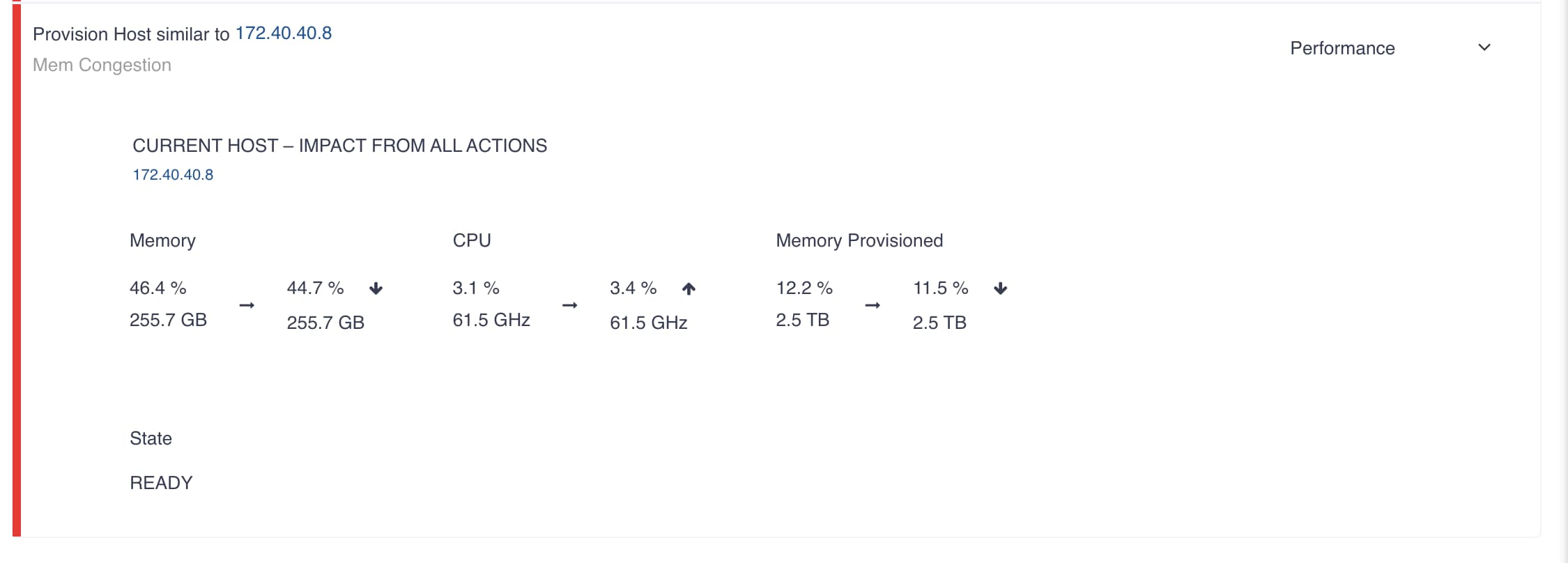
Recommendation to provision a new host to avoid congestion
Policies set business rules to control the ways in which Cisco Intersight Workload Optimizer analyzes resource allocation, displays resource status, and recommends and implements actions (Figure 26).
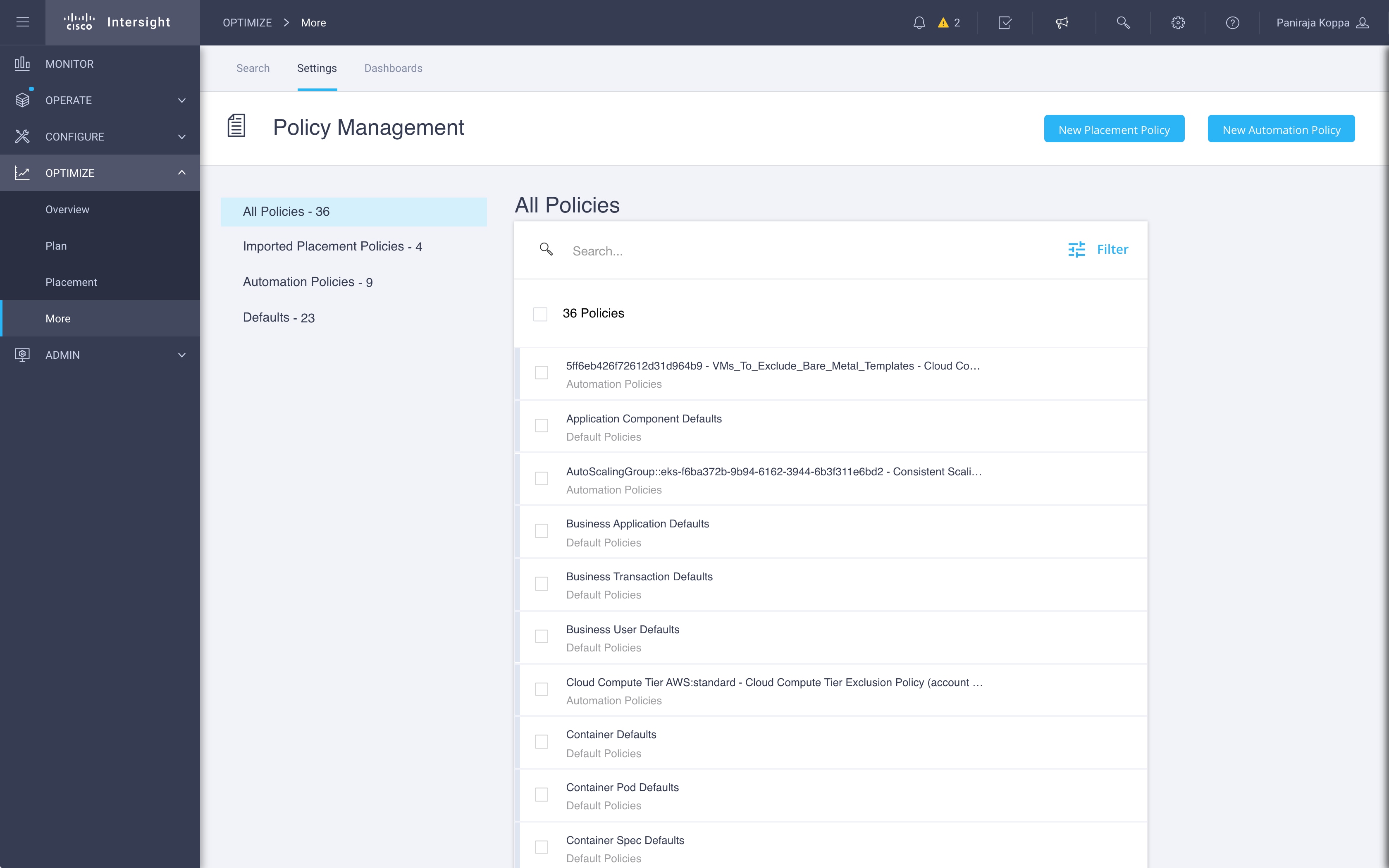
Policy management
The Policy Management page shows all the currently defined policies. From this page you can do the following:
● Create new policies.
● Delete a user-created policy.
● Edit a default or user-created policy.
● Enable or disable discovered placement policies. For a Cisco Intersight Workload Optimizer segment (a placement policy that was created in Workload Optimizer), you can edit the policy definition as well as enable and disable the policy.
Cisco Intersight Workload Optimizer includes two fundamental types of policies: placement policies and automation policies.
For optimization, Cisco Intersight Workload Optimizer recommends actions to place workloads for certain objects such as virtual machines on a disk array, host, etc. Workload Optimizer can recommend these actions or implement them automatically.
When calculating workload placement, Cisco Intersight Workload Optimizer respects cluster boundaries, networks, and provisioned data stores. In addition, the configuration of your environment can specify logical boundaries, and within Workload Optimizer you can create even more boundaries. These boundaries impose segments on the market that Workload Optimizer uses to model your application infrastructure. Workload Optimizer discovers placement rules that are defined by the targets in your environment, and you can create your own segments.
Cisco Intersight Workload Optimizer supports the following placement policies:
● Place: Specify which entities use specific providers.
● Don't Place: Consumers must never run on specific providers.
● Merge: Merge clusters into a single provider group.
● License: Set up hosts with paid licenses to be the preferred providers for virtual machines or applications that require those licenses.
Figure 27 shows a placement policy that explicitly specifies placing all virtual machines with I/O-intensive workloads on an all-flash storage device.
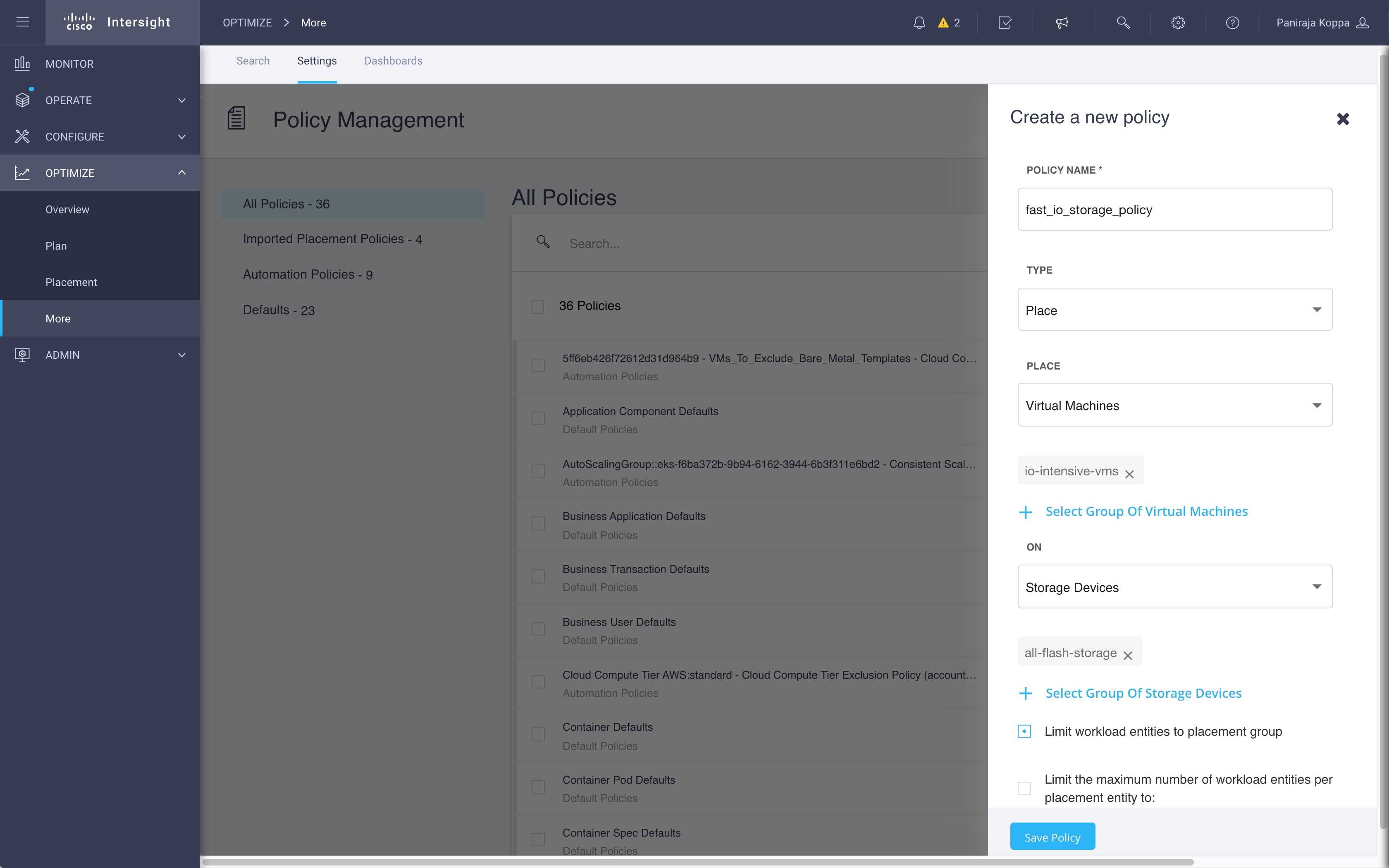
Using a placement policy
To avoid problems in your environment, Cisco Intersight Workload Optimizer identifies actions that you can execute to keep your system running in an optimal way. You can specify the degree of automation you want for these given actions. For example, in some environments you may not want to automate the downsizing of virtual machines because that is a disruptive action. You would use action modes in a policy to set that business rule. Action modes specify the degree of automation for the generated actions.
Cisco Intersight Workload Optimizer supports the following action modes:
● Recommend: Recommend the action so a user can implement it through the given hypervisor or through other means such as storage management software.
● Manual: Recommend the action and provide the option to implement that action through the Cisco Intersight Workload Optimizer user interface.
● Automated: Implement the action automatically.
● Disabled: Do not generate actions. Cisco Intersight Workload Optimizer will not consider recommending disabled actions when it performs its analysis.
Cisco Intersight Workload Optimizer ships with default automation policy settings for the various types of entities it can discover. The settings for these default policies should be adequate to meet initial business requirements. These policies apply to the global scope. You can edit these entity settings based on your requirements.
With Cisco Intersight Workload Optimizer and FlexPod Datacenter, IT operations teams can easily manage and automate application resource management at scale and help ensure the performance of applications. This solution provides full-stack visibility of applications and the underlying infrastructure, intelligent insights, and automated actions. You can also reduce costs and preserve capital by effectively increasing resource utilization in your FlexPod environment.
For additional information, see the following resources:
● Cisco and NetApp Solutions:
https://www.cisco.com/site/us/en/solutions/computing/converged-infrastructure/flexpod/index.html
● Cisco Intersight Workload Optimizer data sheet: https://www.cisco.com/c/en/us/products/collateral/cloud-systems-management/intersight-workload-optimizer/datasheet-c78-744509.html
● Information about Cisco Intersight Workload Optimizer: https://www.cisco.com/site/in/en/products/computing/hybrid-cloud-operations/intersight-workload-optimizer/index.html
● Cisco Intersight data sheet and ordering information: https://www.cisco.com/c/en/us/products/collateral/servers-unified-computing/intersight/datasheet-c78-739433.html
● Cisco Intersight Workload Optimizer online help: https://intersight.com/help/resources#cisco_intersight_workload_optimizer
● Cisco Intersight Workload Optimizer Getting Started Guide: https://intersight.com/help/resources/cisco_intersight_workload_optimizer_getting_started
● Cisco Intersight Workload Optimizer User Guide: https://cdn.intersight.com/components/an-hulk/1.0.9-685/docs/cloud/data/resources/iwo/Cisco_Intersight_Workload_Optimizer_User_Guide.pdf
● Cisco Intersight Workload Optimizer Target Configuration Guide: https://cdn.intersight.com/components/an-hulk/1.0.9-685/docs/cloud/data/resources/iwo/Cisco_Intersight_Workload_Optimizer_Target_Configuration_Guide.pdf